Authz as a dev workflow: architecting better cloud native apps
A presentation at KubeCon + CloudNativeCon EU 2025 in in London, UK by Daniel "phrawzty" Maher
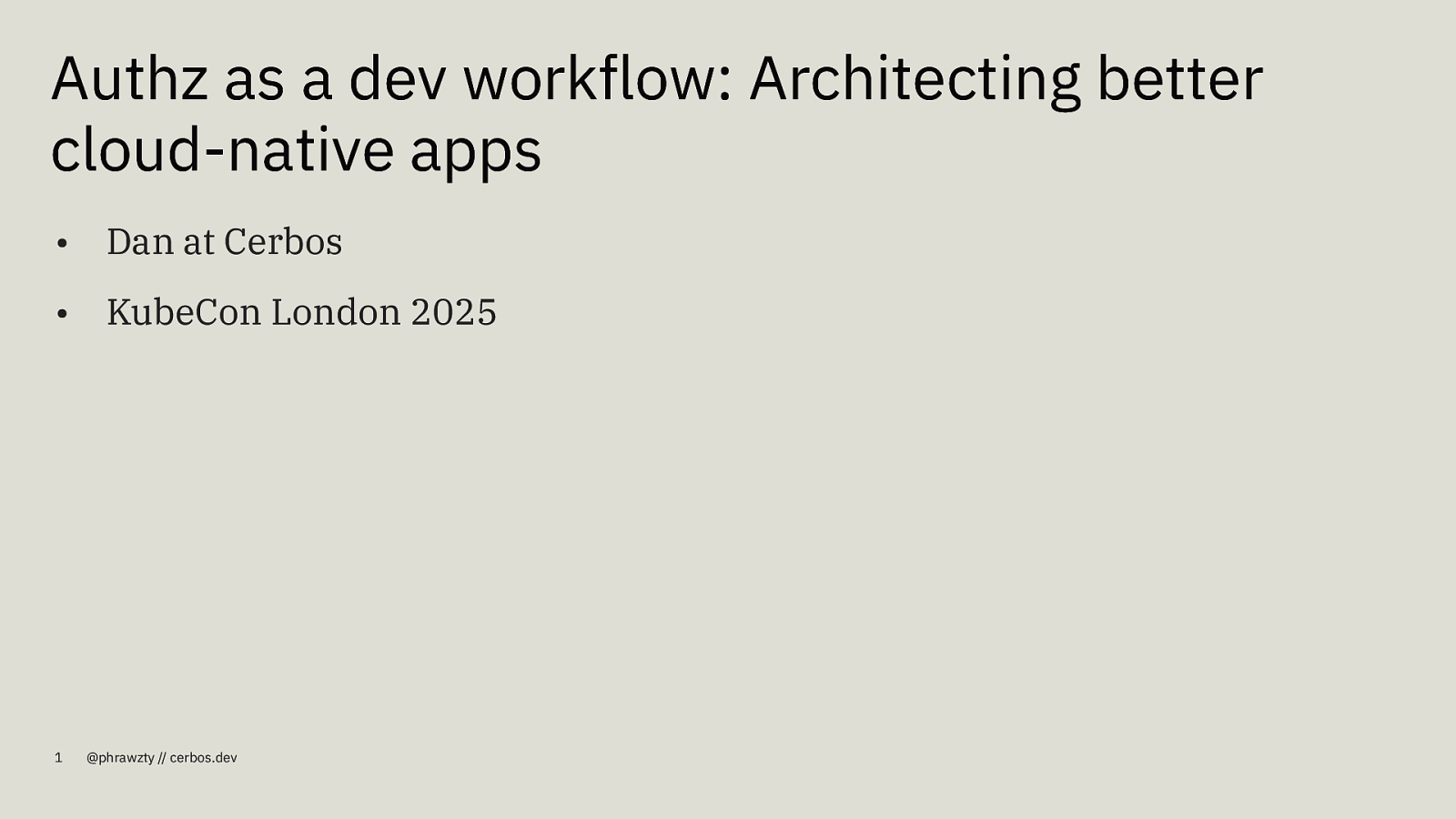
Authz as a dev workflow: Architecting better cloud-native apps • Dan at Cerbos • KubeCon London 2025 1 @phrawzty // cerbos.dev
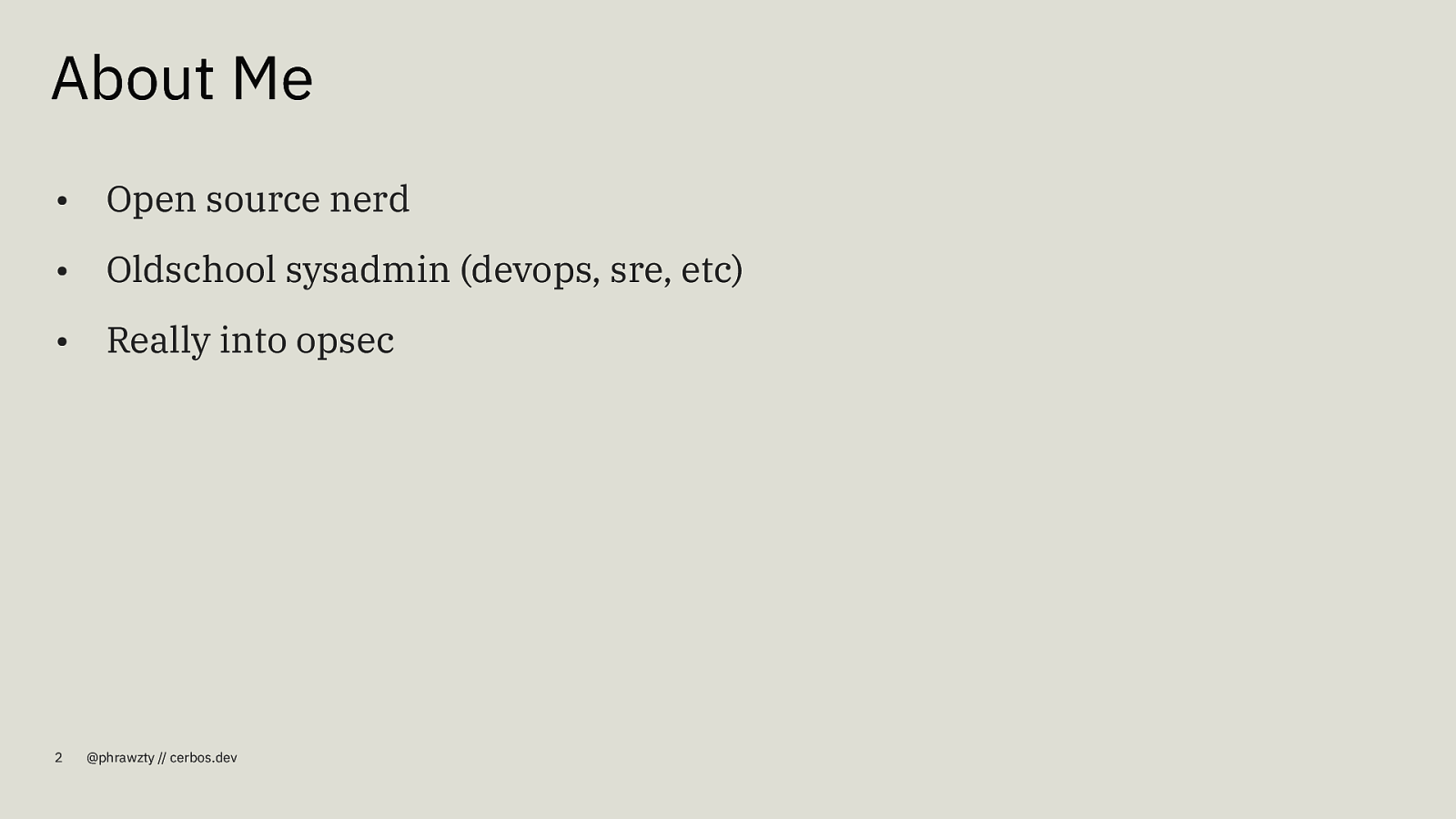
About Me • Open source nerd • Oldschool sysadmin (devops, sre, etc) • Really into opsec 2 @phrawzty // cerbos.dev
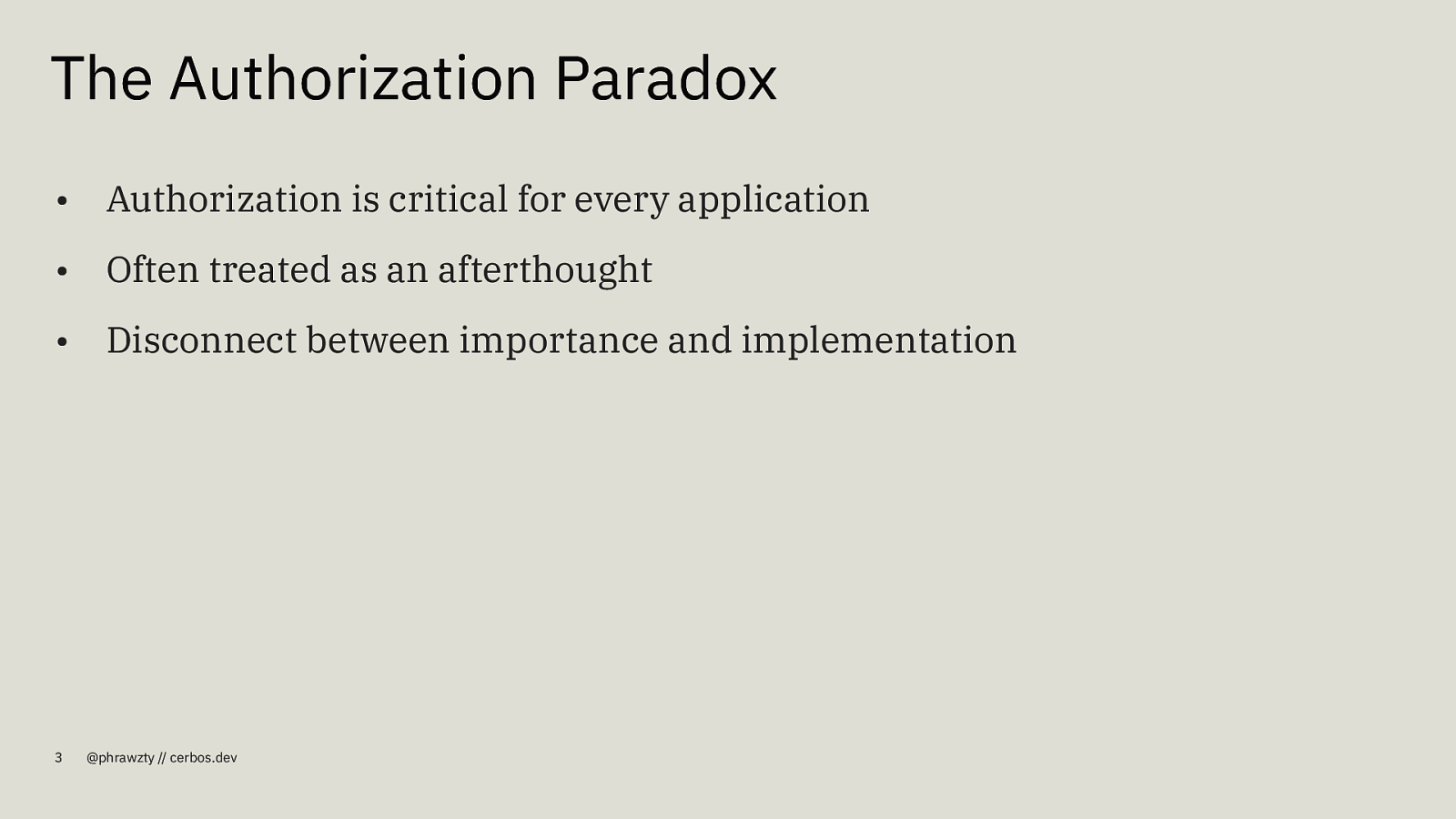
The Authorization Paradox • Authorization is critical for every application • Often treated as an afterthought • Disconnect between importance and implementation 3 @phrawzty // cerbos.dev

The Evolution of Developer Primitives • Consider how cloud-native development has evolved • Networking: From manual configuration to service mesh and CNI • Storage: From volume management to persistent volume claims and CSI • Deployment: From manual scripts to GitOps and CI/CD pipelines • Each evolved from infrastructure concerns to developer primitives • Each transformation made developers more productive while improving quality 4 @phrawzty // cerbos.dev
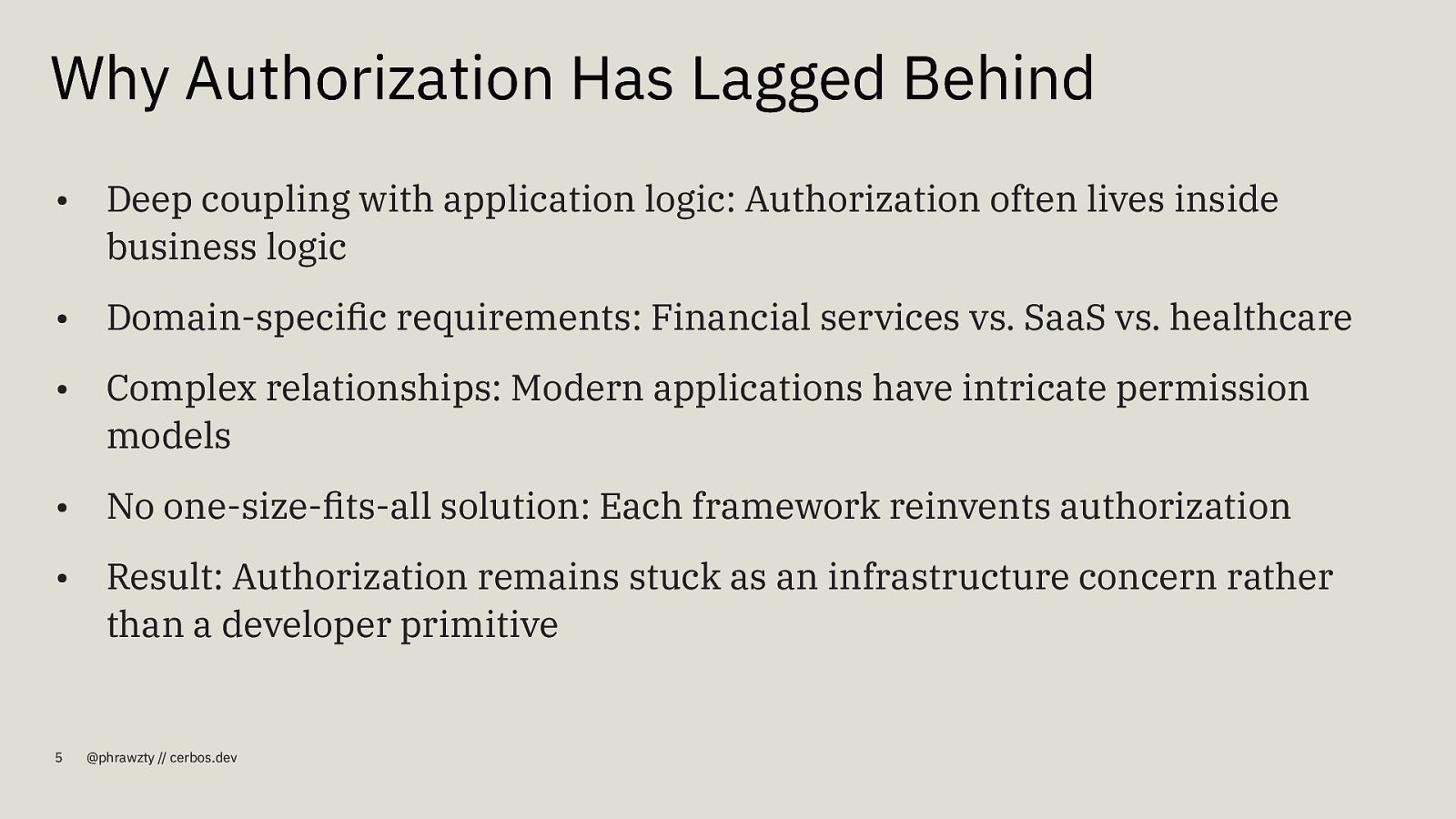
Why Authorization Has Lagged Behind • Deep coupling with application logic: Authorization often lives inside business logic • Domain-specific requirements: Financial services vs. SaaS vs. healthcare • Complex relationships: Modern applications have intricate permission models • No one-size-fits-all solution: Each framework reinvents authorization • Result: Authorization remains stuck as an infrastructure concern rather than a developer primitive 5 @phrawzty // cerbos.dev
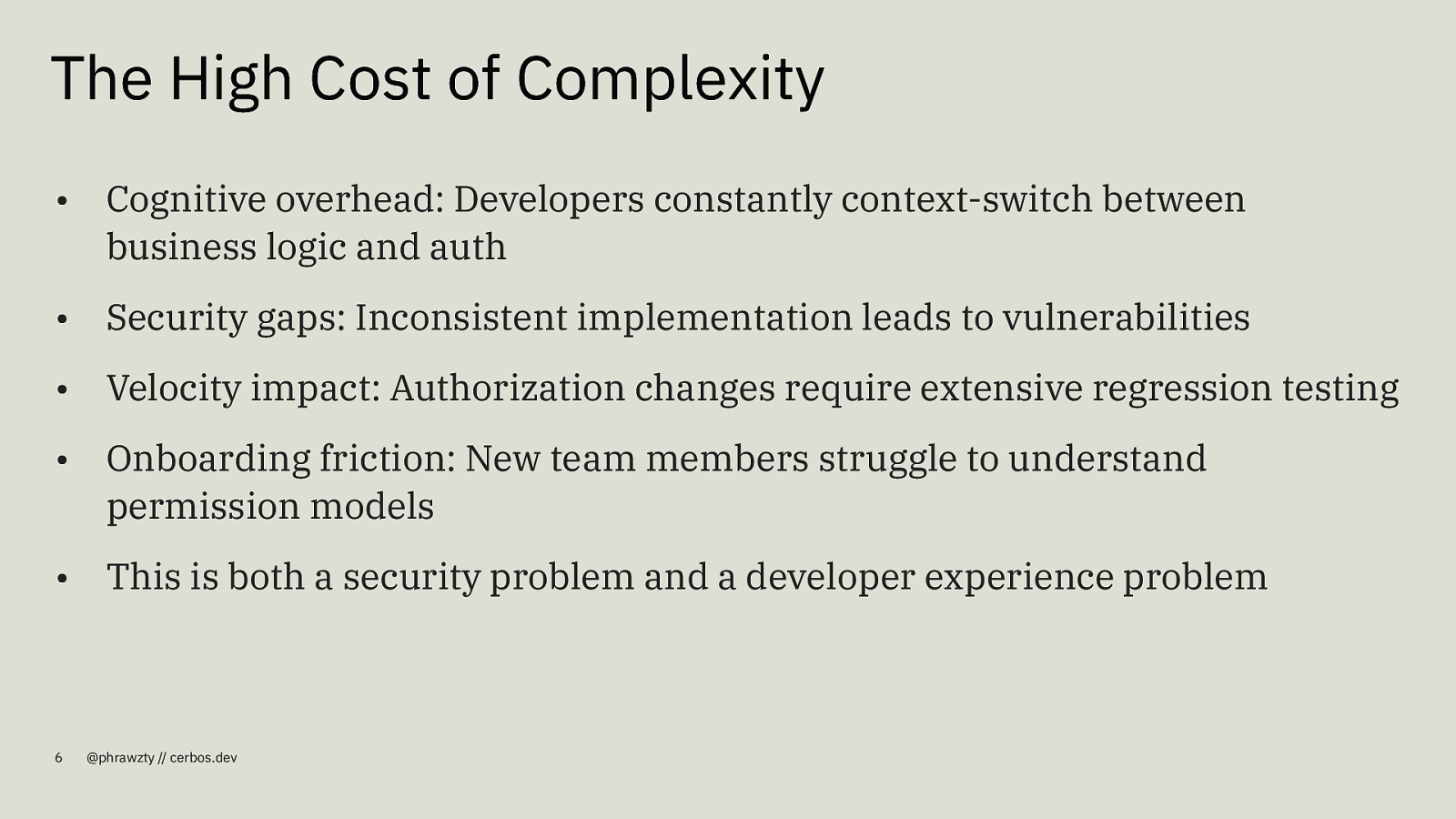
The High Cost of Complexity • Cognitive overhead: Developers constantly context-switch between business logic and auth • Security gaps: Inconsistent implementation leads to vulnerabilities • Velocity impact: Authorization changes require extensive regression testing • Onboarding friction: New team members struggle to understand permission models • This is both a security problem and a developer experience problem 6 @phrawzty // cerbos.dev
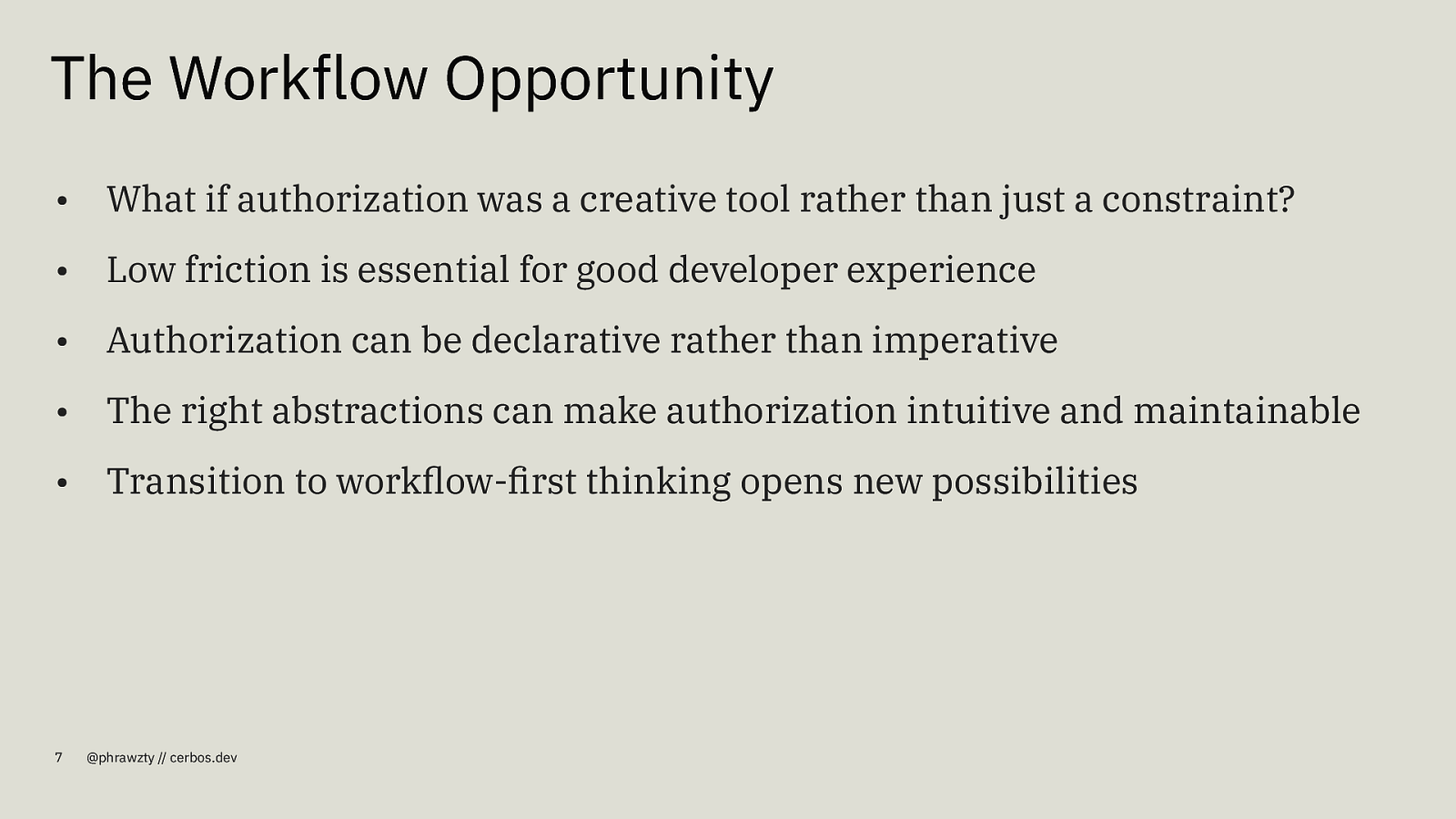
The Workflow Opportunity • What if authorization was a creative tool rather than just a constraint? • Low friction is essential for good developer experience • Authorization can be declarative rather than imperative • The right abstractions can make authorization intuitive and maintainable • Transition to workflow-first thinking opens new possibilities 7 @phrawzty // cerbos.dev
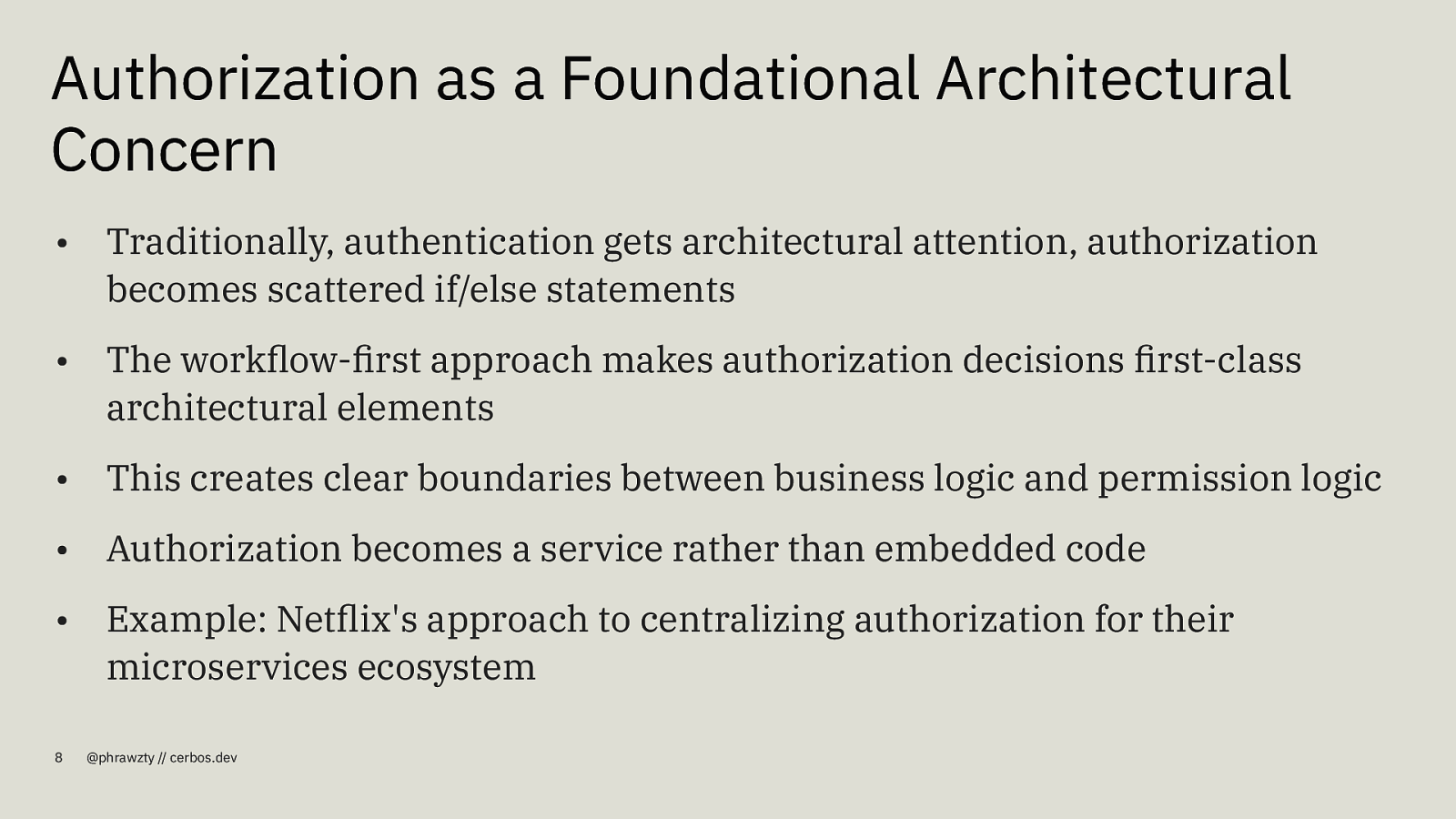
Authorization as a Foundational Architectural Concern • Traditionally, authentication gets architectural attention, authorization becomes scattered if/else statements • The workflow-first approach makes authorization decisions first-class architectural elements • This creates clear boundaries between business logic and permission logic • Authorization becomes a service rather than embedded code • Example: Netflix’s approach to centralizing authorization for their microservices ecosystem 8 @phrawzty // cerbos.dev
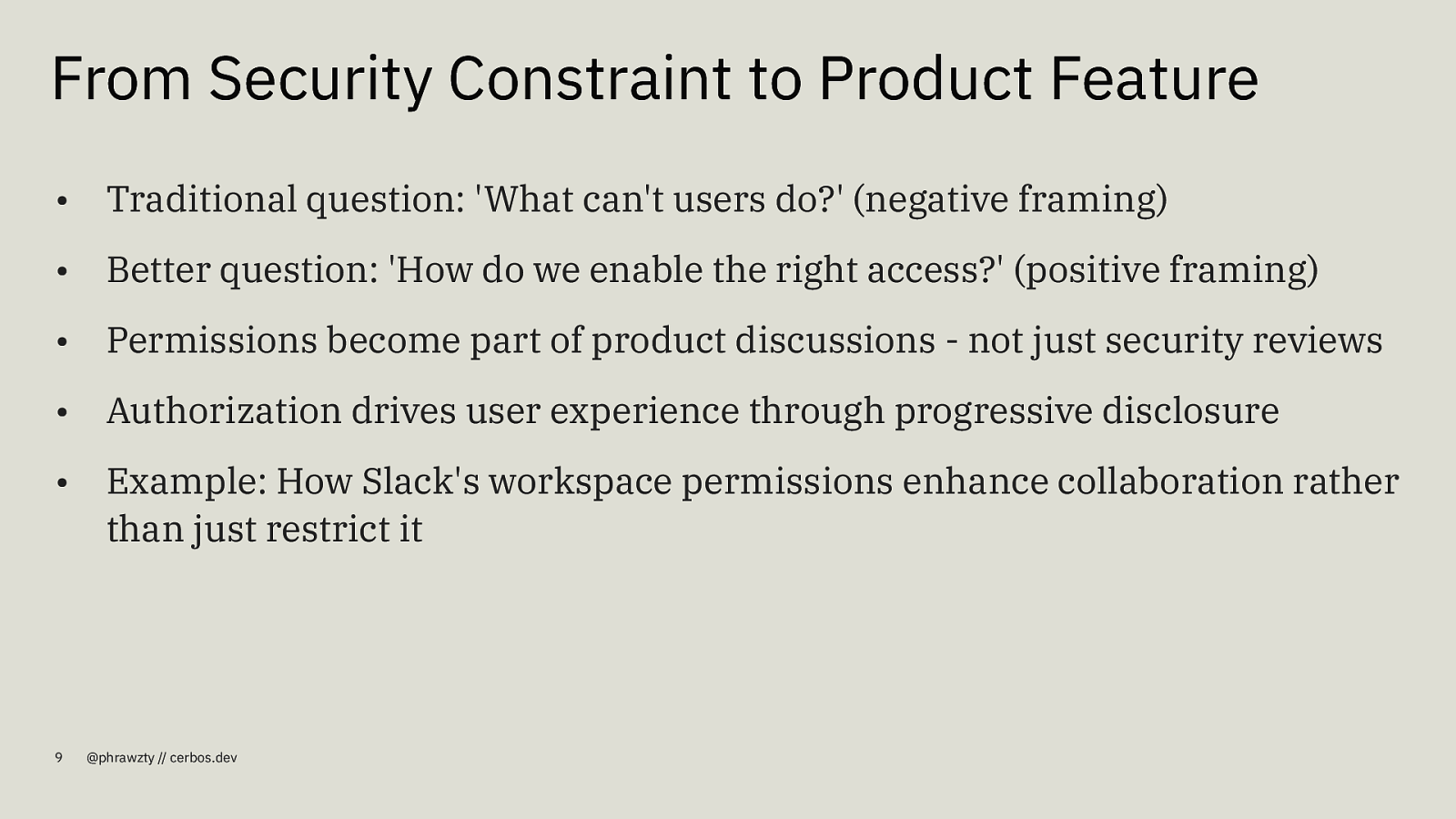
From Security Constraint to Product Feature • Traditional question: ‘What can’t users do?’ (negative framing) • Better question: ‘How do we enable the right access?’ (positive framing) • Permissions become part of product discussions - not just security reviews • Authorization drives user experience through progressive disclosure • Example: How Slack’s workspace permissions enhance collaboration rather than just restrict it 9 @phrawzty // cerbos.dev
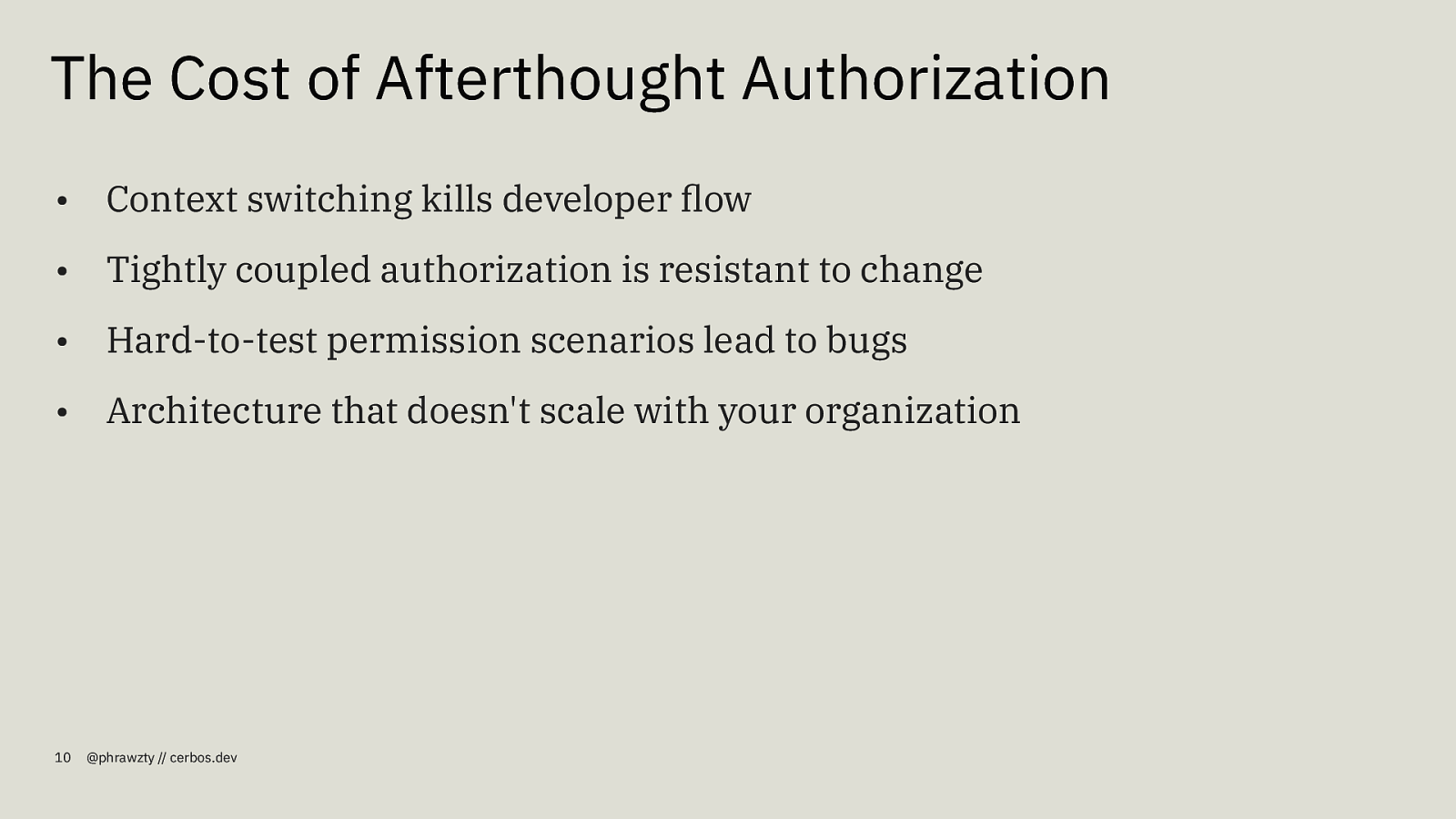
The Cost of Afterthought Authorization • Context switching kills developer flow • Tightly coupled authorization is resistant to change • Hard-to-test permission scenarios lead to bugs • Architecture that doesn’t scale with your organization 10 @phrawzty // cerbos.dev
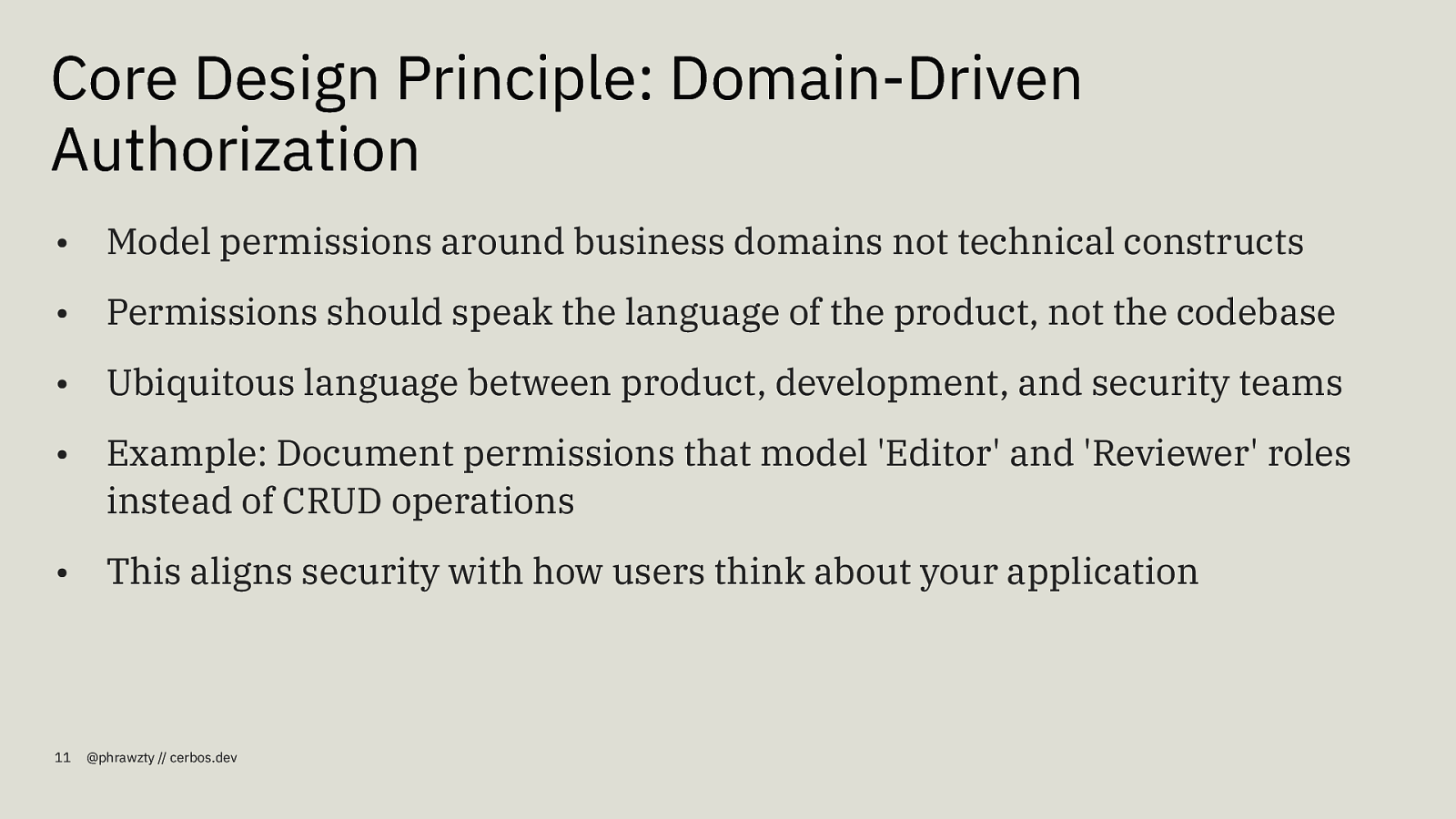
Core Design Principle: Domain-Driven Authorization • Model permissions around business domains not technical constructs • Permissions should speak the language of the product, not the codebase • Ubiquitous language between product, development, and security teams • Example: Document permissions that model ‘Editor’ and ‘Reviewer’ roles instead of CRUD operations • This aligns security with how users think about your application 11 @phrawzty // cerbos.dev
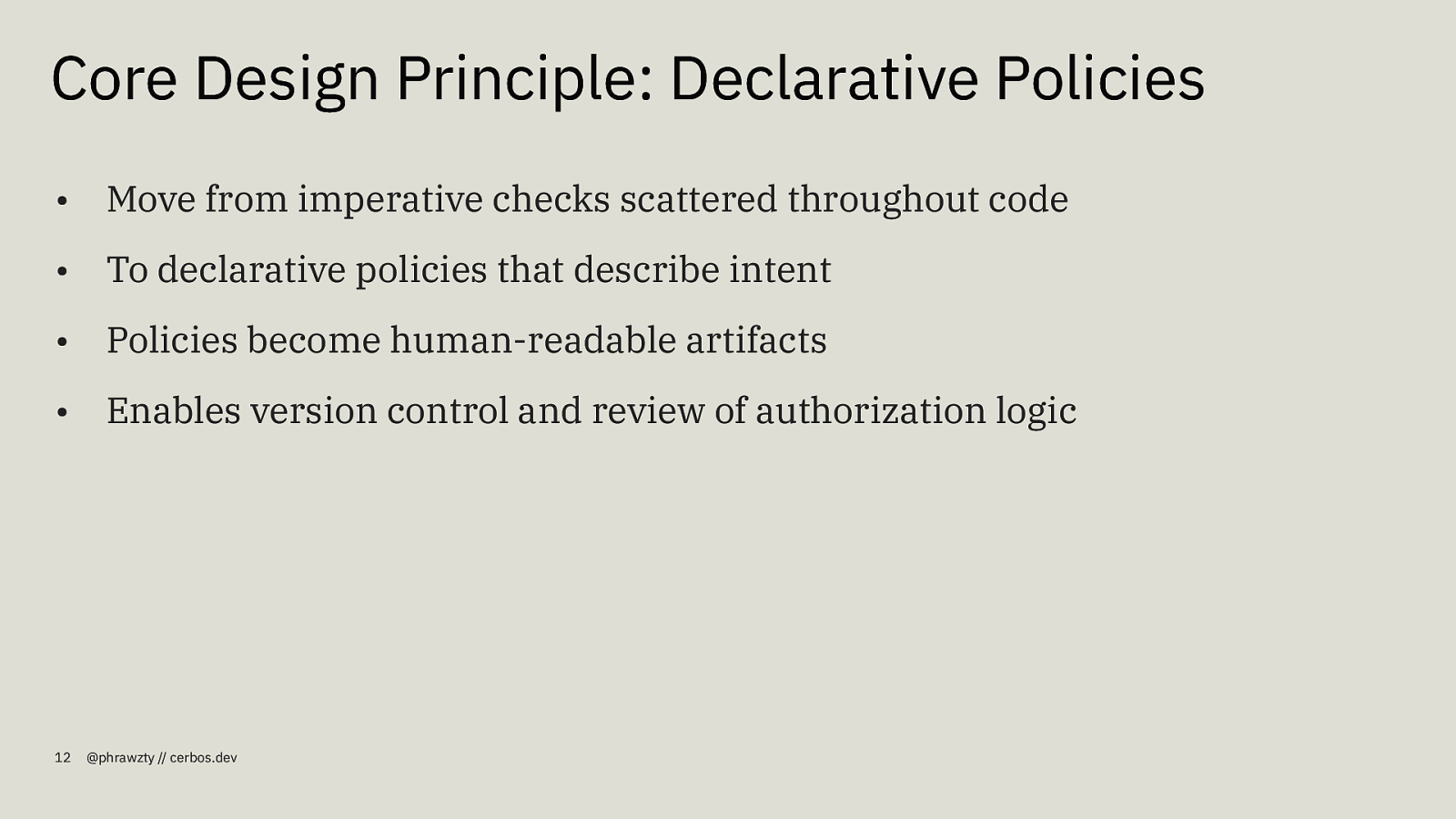
Core Design Principle: Declarative Policies • Move from imperative checks scattered throughout code • To declarative policies that describe intent • Policies become human-readable artifacts • Enables version control and review of authorization logic 12 @phrawzty // cerbos.dev
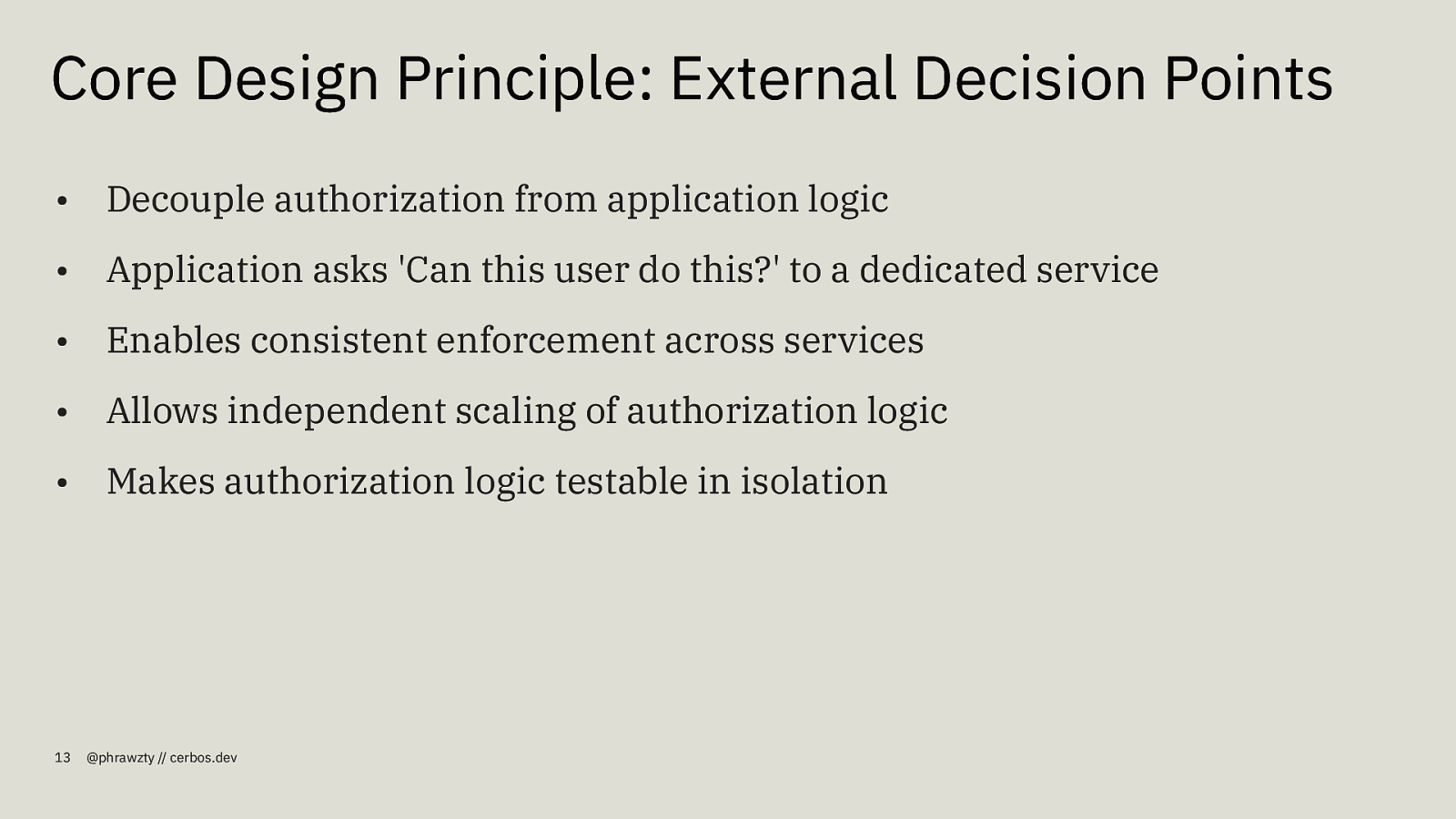
Core Design Principle: External Decision Points • Decouple authorization from application logic • Application asks ‘Can this user do this?’ to a dedicated service • Enables consistent enforcement across services • Allows independent scaling of authorization logic • Makes authorization logic testable in isolation 13 @phrawzty // cerbos.dev
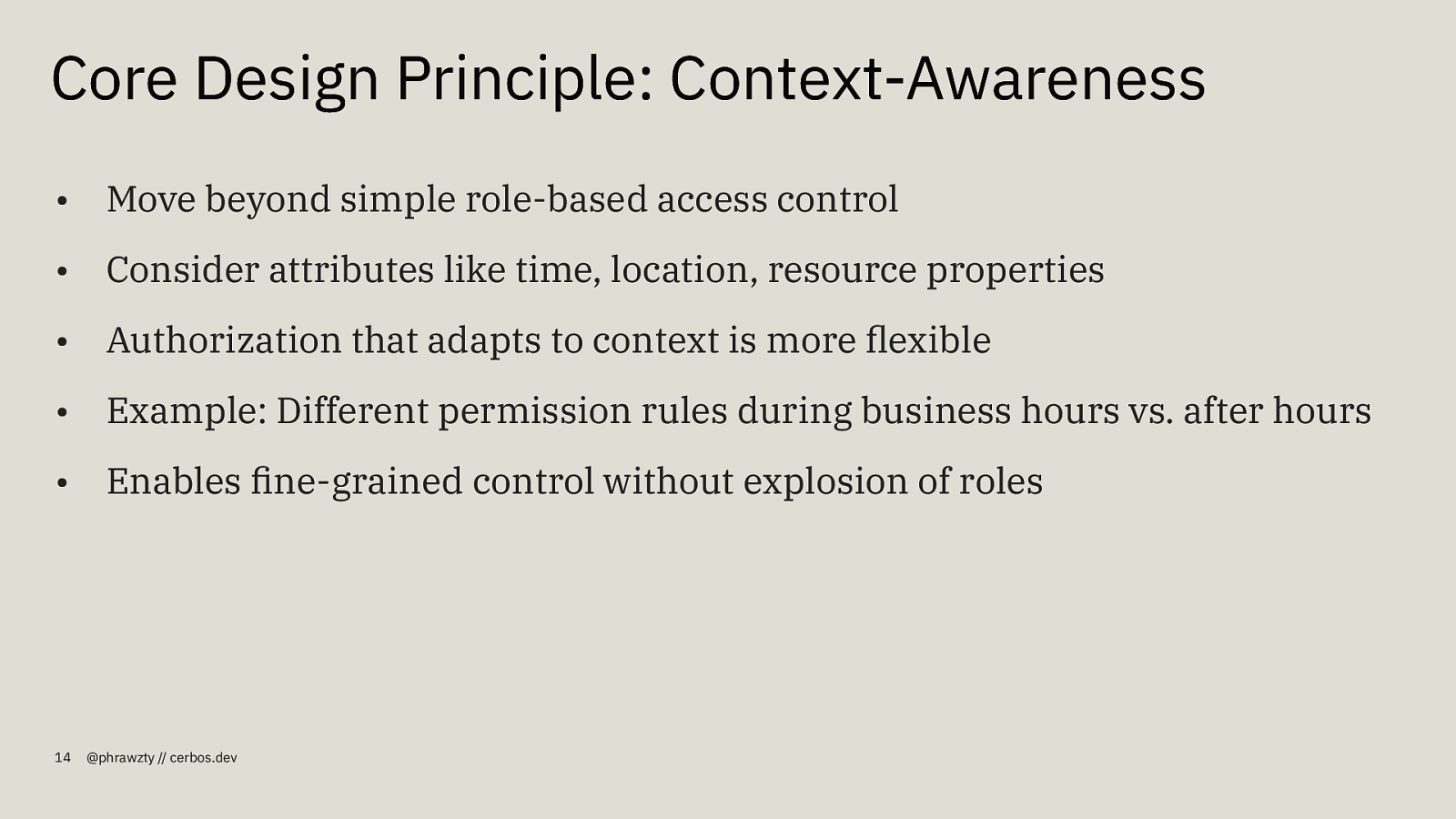
Core Design Principle: Context-Awareness • Move beyond simple role-based access control • Consider attributes like time, location, resource properties • Authorization that adapts to context is more flexible • Example: Different permission rules during business hours vs. after hours • Enables fine-grained control without explosion of roles 14 @phrawzty // cerbos.dev

Integration Points in the Development Lifecycle • Requirements gathering: Define permission models alongside features • API design: Document authorization requirements in API specs • Implementation: Clear interfaces for authorization checks • Testing: Dedicated test suites for permission logic • Operations: Monitoring and observability for authorization decisions • This creates a continuous thread of authorization awareness 15 @phrawzty // cerbos.dev
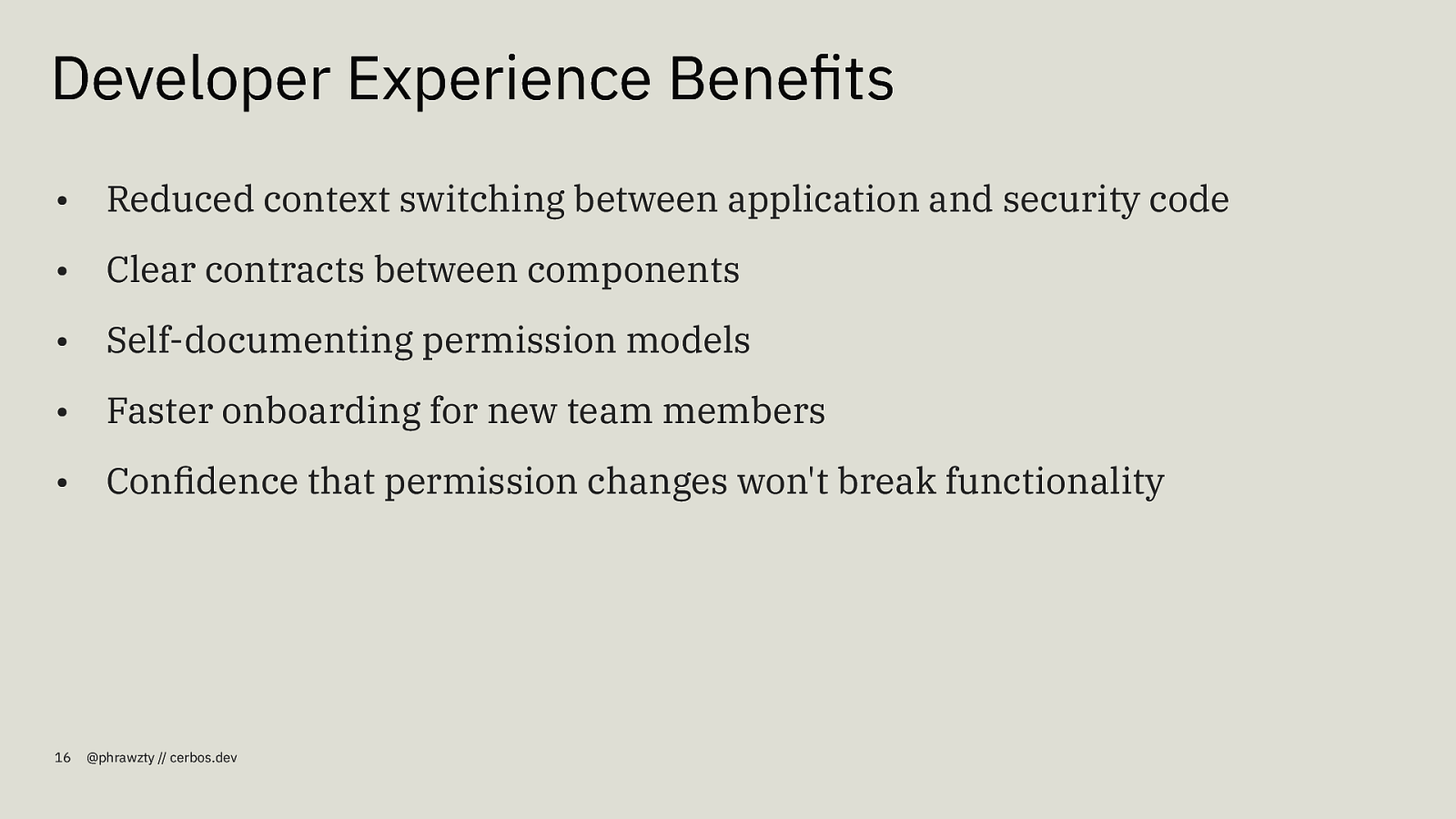
Developer Experience Benefits • Reduced context switching between application and security code • Clear contracts between components • Self-documenting permission models • Faster onboarding for new team members • Confidence that permission changes won’t break functionality 16 @phrawzty // cerbos.dev
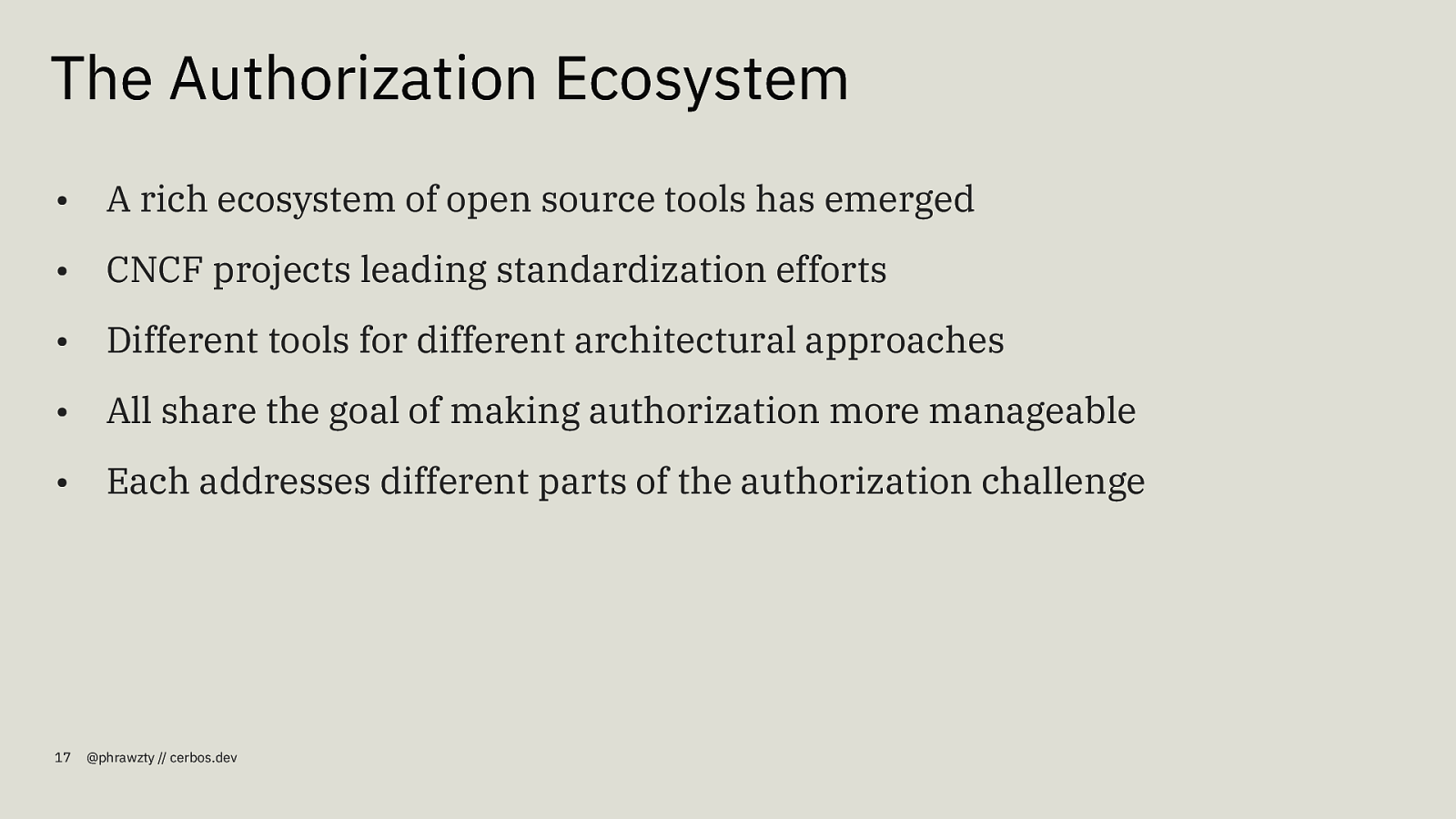
The Authorization Ecosystem • A rich ecosystem of open source tools has emerged • CNCF projects leading standardization efforts • Different tools for different architectural approaches • All share the goal of making authorization more manageable • Each addresses different parts of the authorization challenge 17 @phrawzty // cerbos.dev
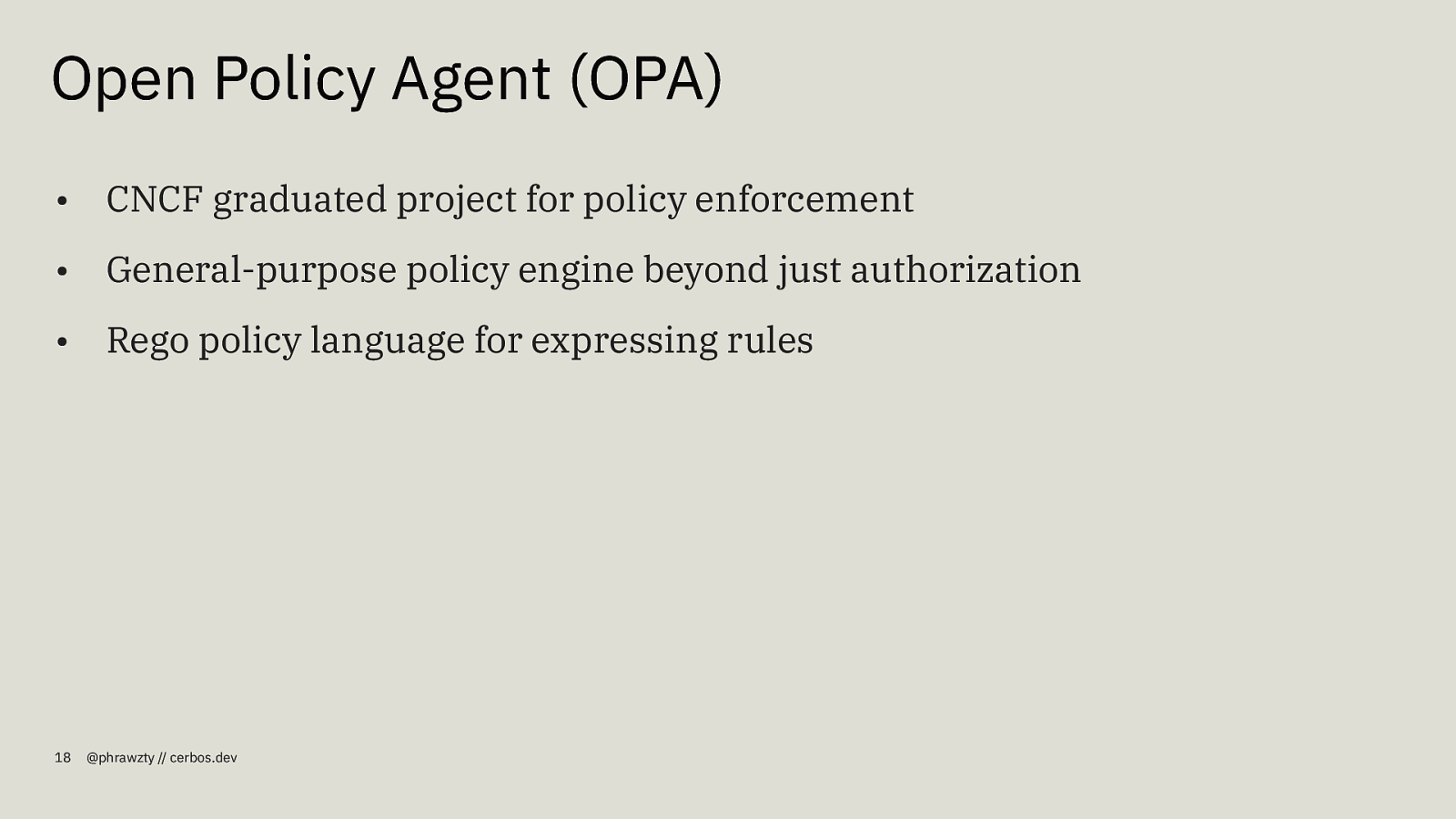
Open Policy Agent (OPA) • CNCF graduated project for policy enforcement • General-purpose policy engine beyond just authorization • Rego policy language for expressing rules 18 @phrawzty // cerbos.dev
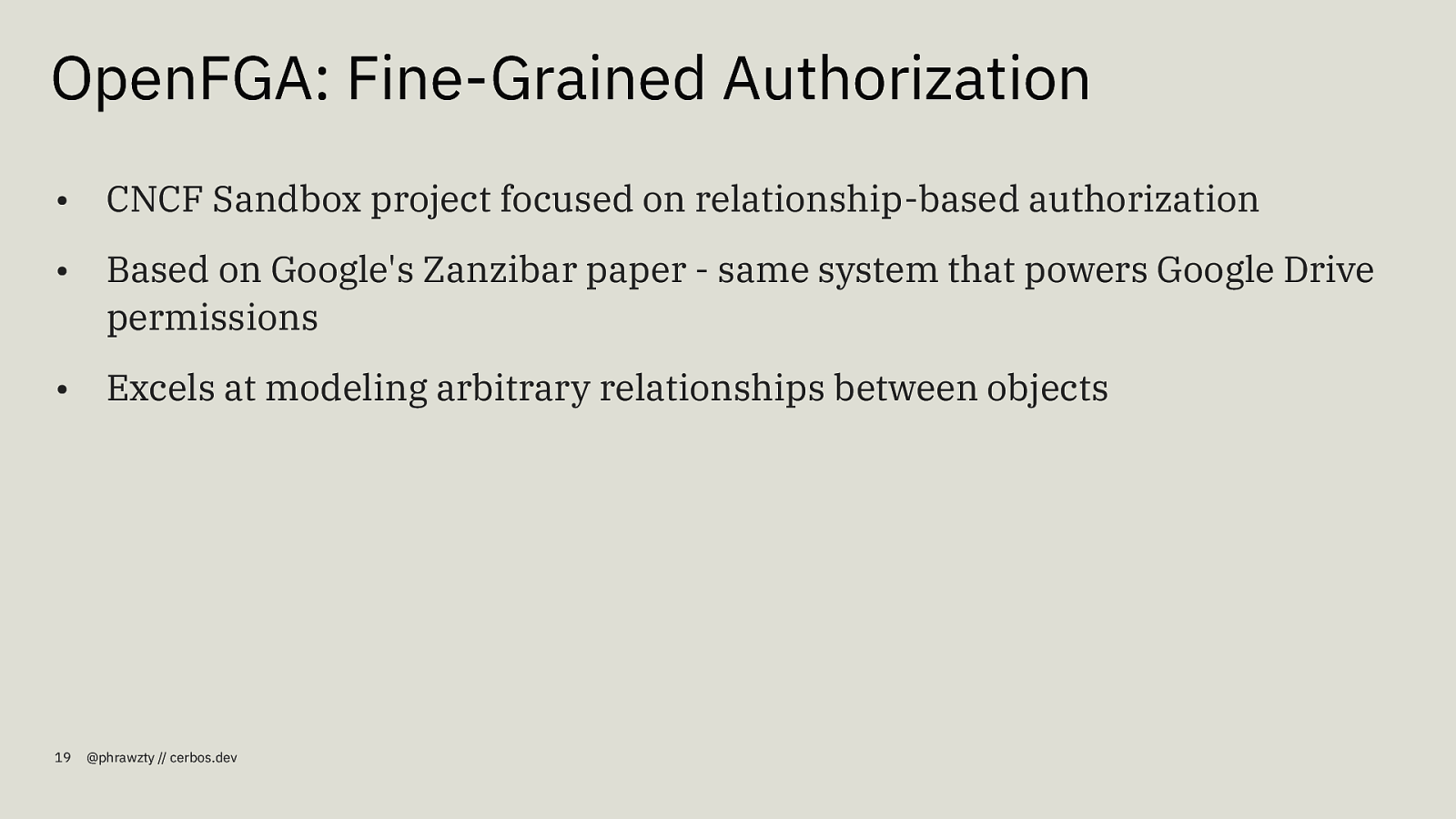
OpenFGA: Fine-Grained Authorization • CNCF Sandbox project focused on relationship-based authorization • Based on Google’s Zanzibar paper - same system that powers Google Drive permissions • Excels at modeling arbitrary relationships between objects 19 @phrawzty // cerbos.dev
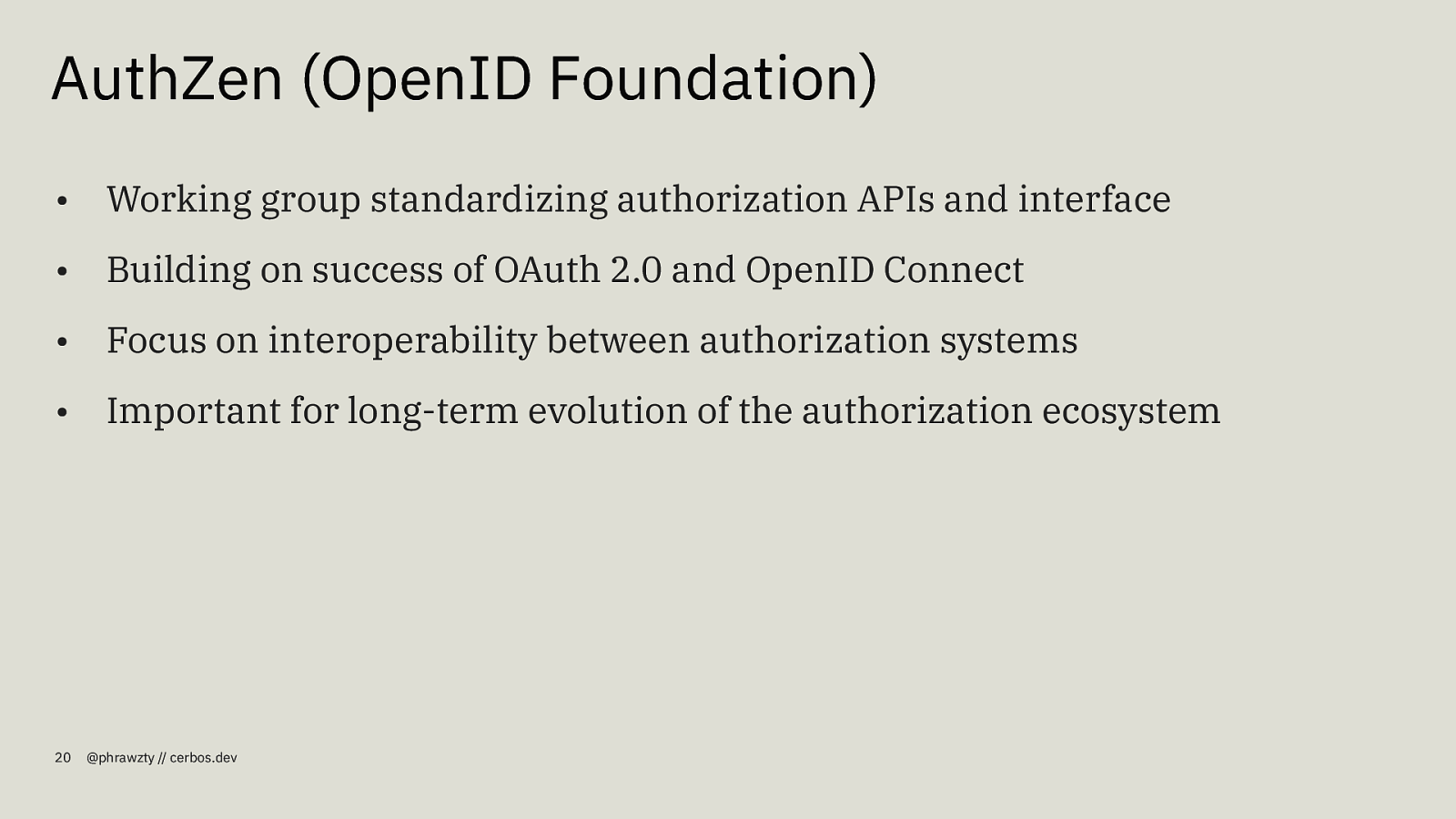
AuthZen (OpenID Foundation) • Working group standardizing authorization APIs and interface • Building on success of OAuth 2.0 and OpenID Connect • Focus on interoperability between authorization systems • Important for long-term evolution of the authorization ecosystem 20 @phrawzty // cerbos.dev
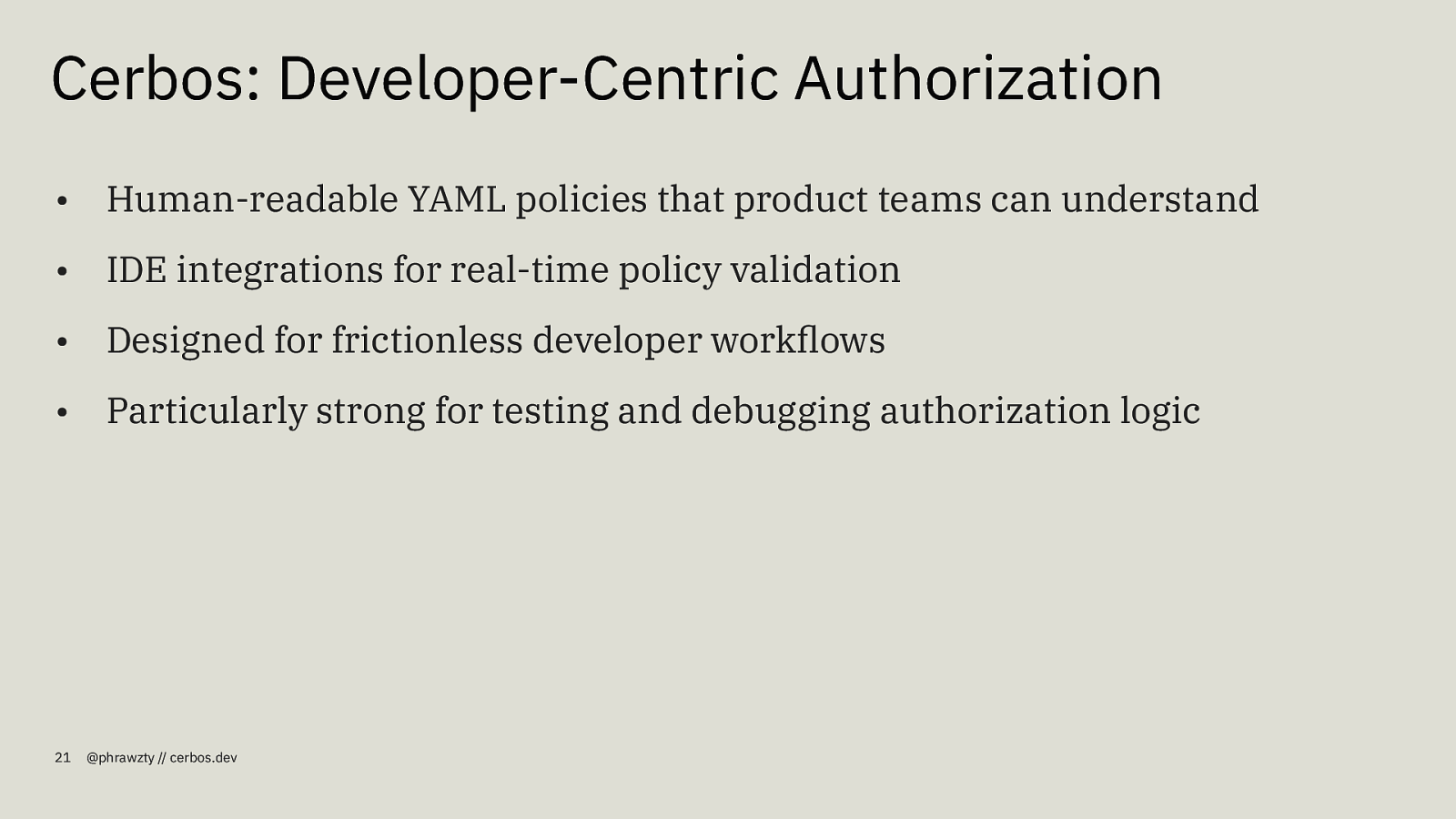
Cerbos: Developer-Centric Authorization • Human-readable YAML policies that product teams can understand • IDE integrations for real-time policy validation • Designed for frictionless developer workflows • Particularly strong for testing and debugging authorization logic 21 @phrawzty // cerbos.dev
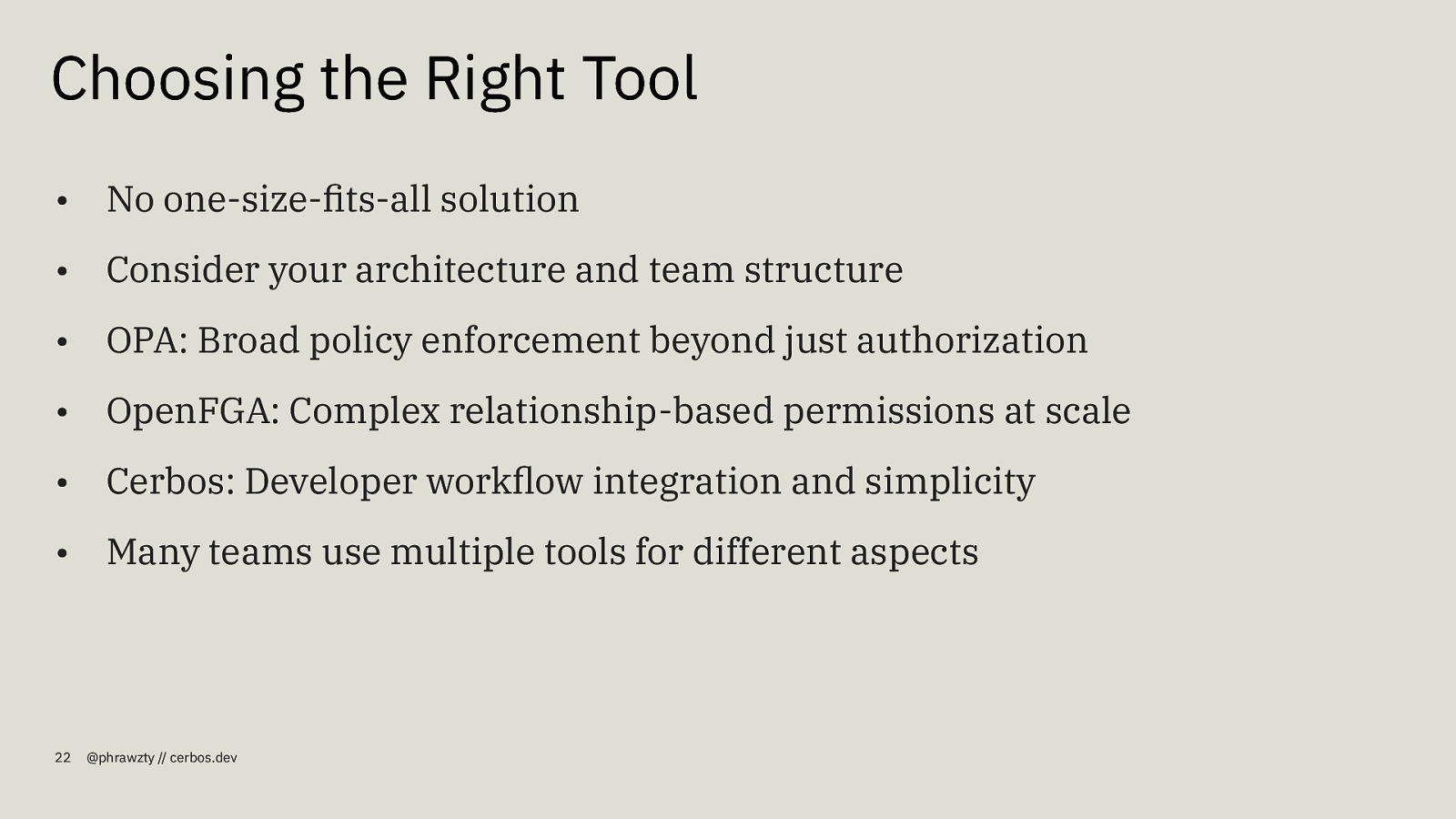
Choosing the Right Tool • No one-size-fits-all solution • Consider your architecture and team structure • OPA: Broad policy enforcement beyond just authorization • OpenFGA: Complex relationship-based permissions at scale • Cerbos: Developer workflow integration and simplicity • Many teams use multiple tools for different aspects 22 @phrawzty // cerbos.dev
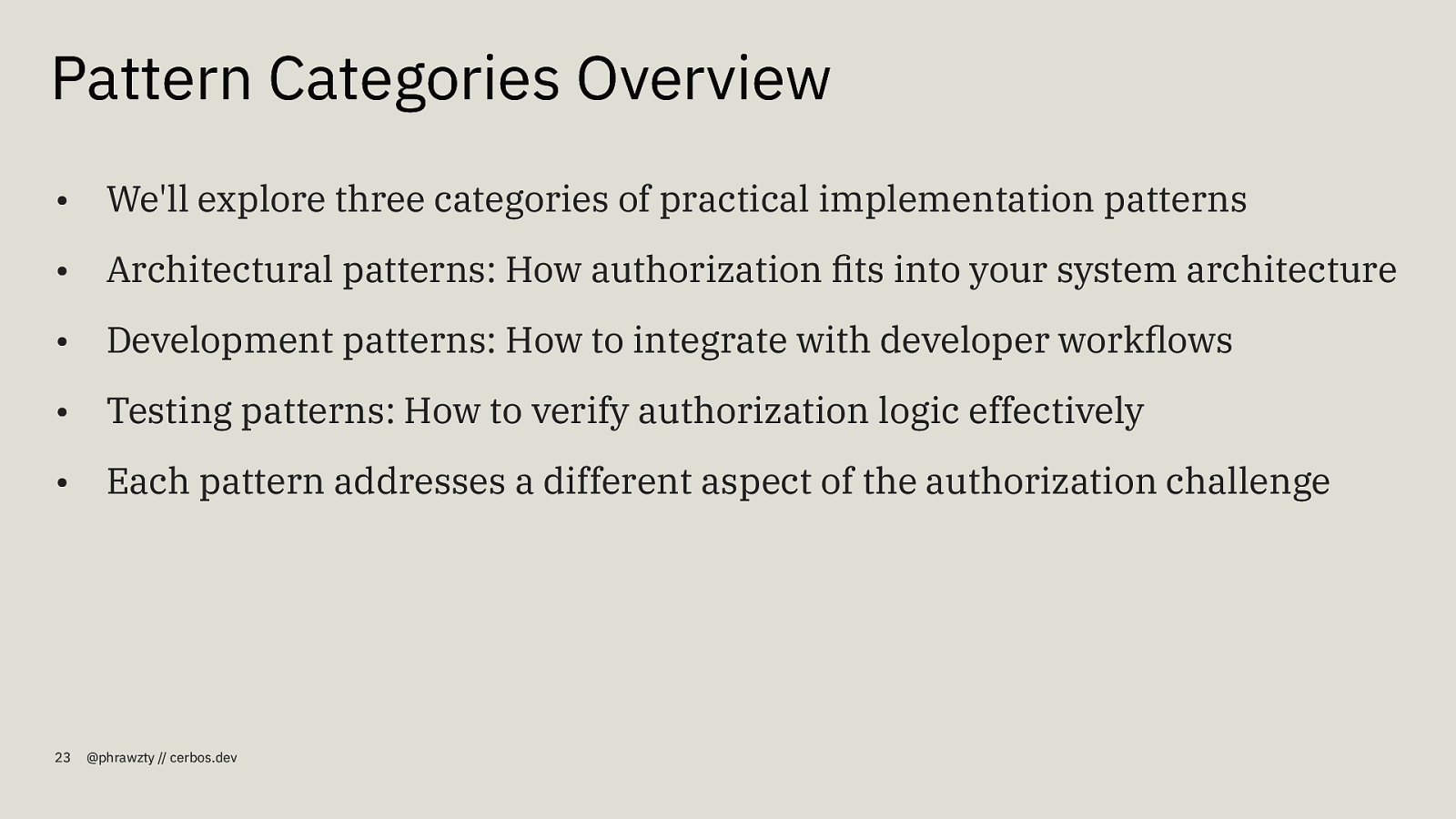
Pattern Categories Overview • We’ll explore three categories of practical implementation patterns • Architectural patterns: How authorization fits into your system architecture • Development patterns: How to integrate with developer workflows • Testing patterns: How to verify authorization logic effectively • Each pattern addresses a different aspect of the authorization challenge 23 @phrawzty // cerbos.dev
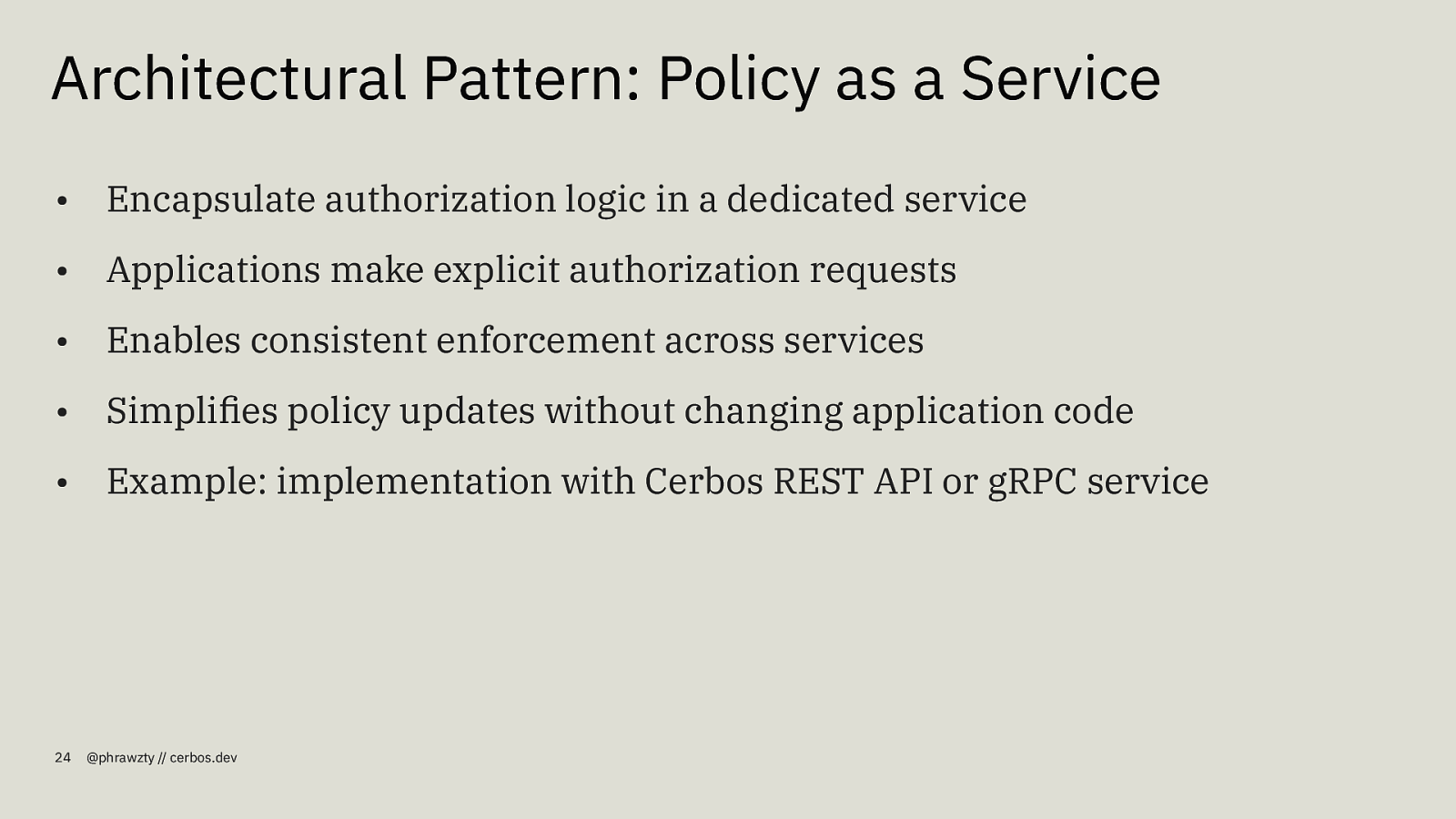
Architectural Pattern: Policy as a Service • Encapsulate authorization logic in a dedicated service • Applications make explicit authorization requests • Enables consistent enforcement across services • Simplifies policy updates without changing application code • Example: implementation with Cerbos REST API or gRPC service 24 @phrawzty // cerbos.dev
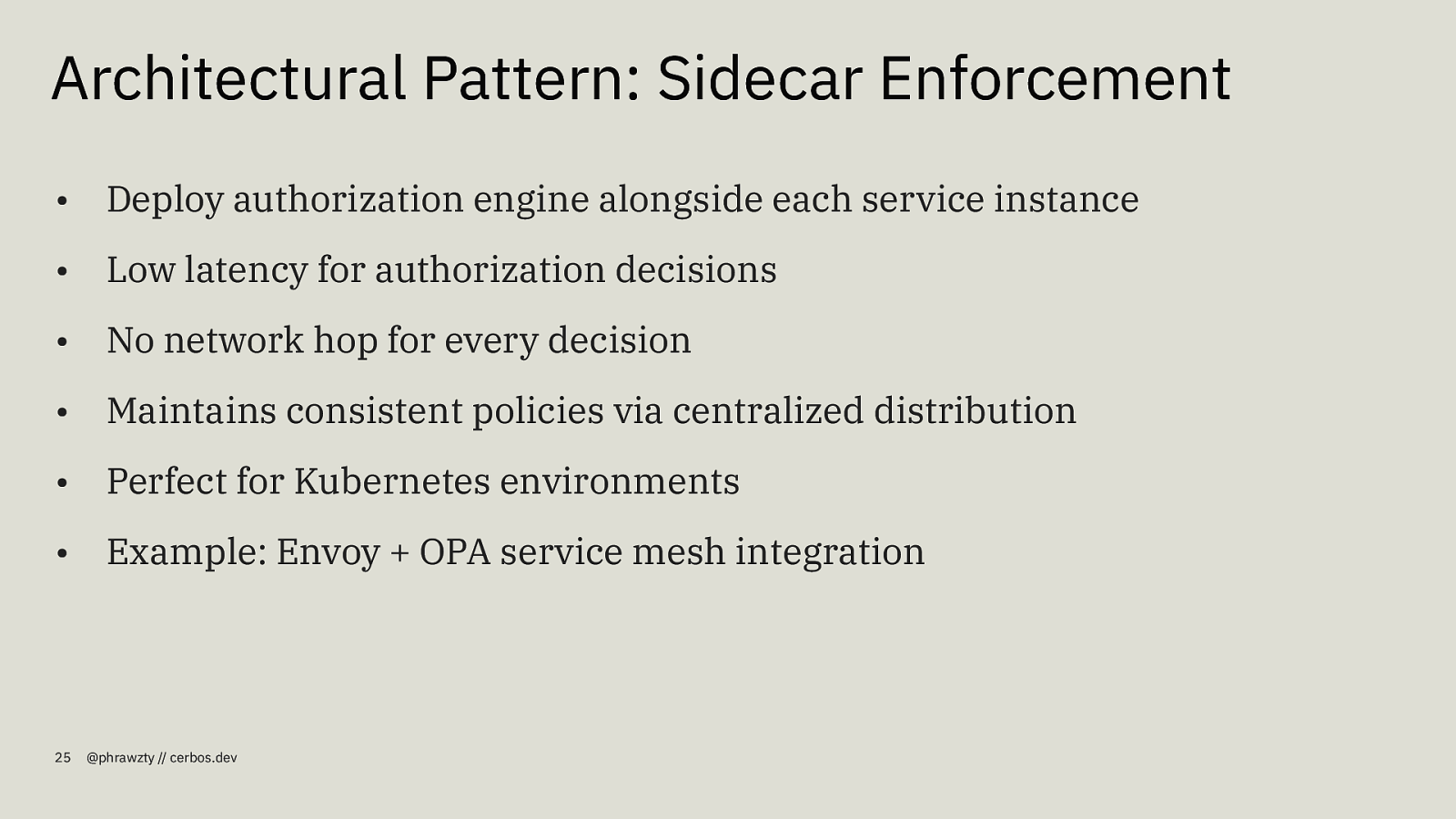
Architectural Pattern: Sidecar Enforcement • Deploy authorization engine alongside each service instance • Low latency for authorization decisions • No network hop for every decision • Maintains consistent policies via centralized distribution • Perfect for Kubernetes environments • Example: Envoy + OPA service mesh integration 25 @phrawzty // cerbos.dev
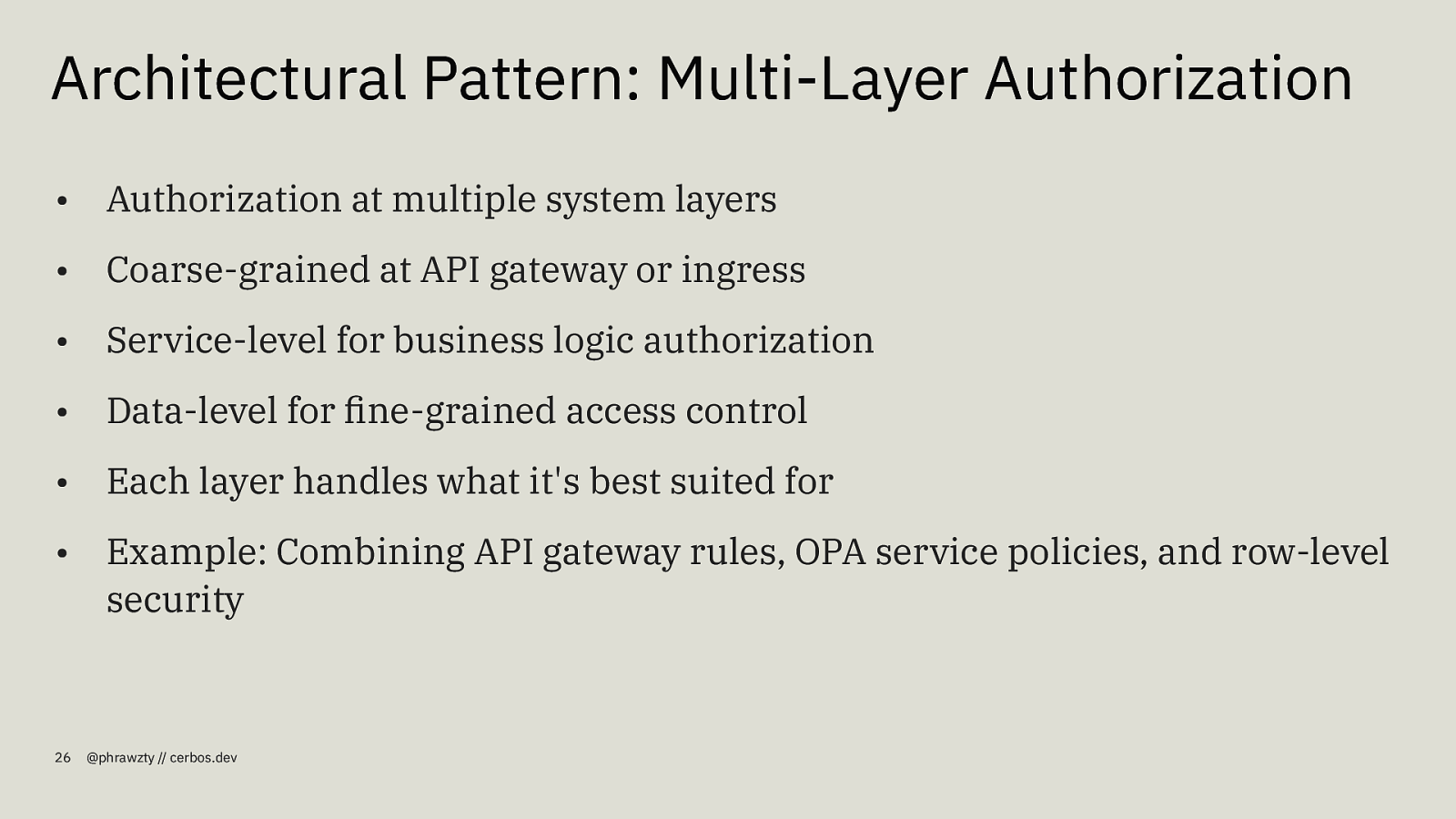
Architectural Pattern: Multi-Layer Authorization • Authorization at multiple system layers • Coarse-grained at API gateway or ingress • Service-level for business logic authorization • Data-level for fine-grained access control • Each layer handles what it’s best suited for • Example: Combining API gateway rules, OPA service policies, and row-level security 26 @phrawzty // cerbos.dev
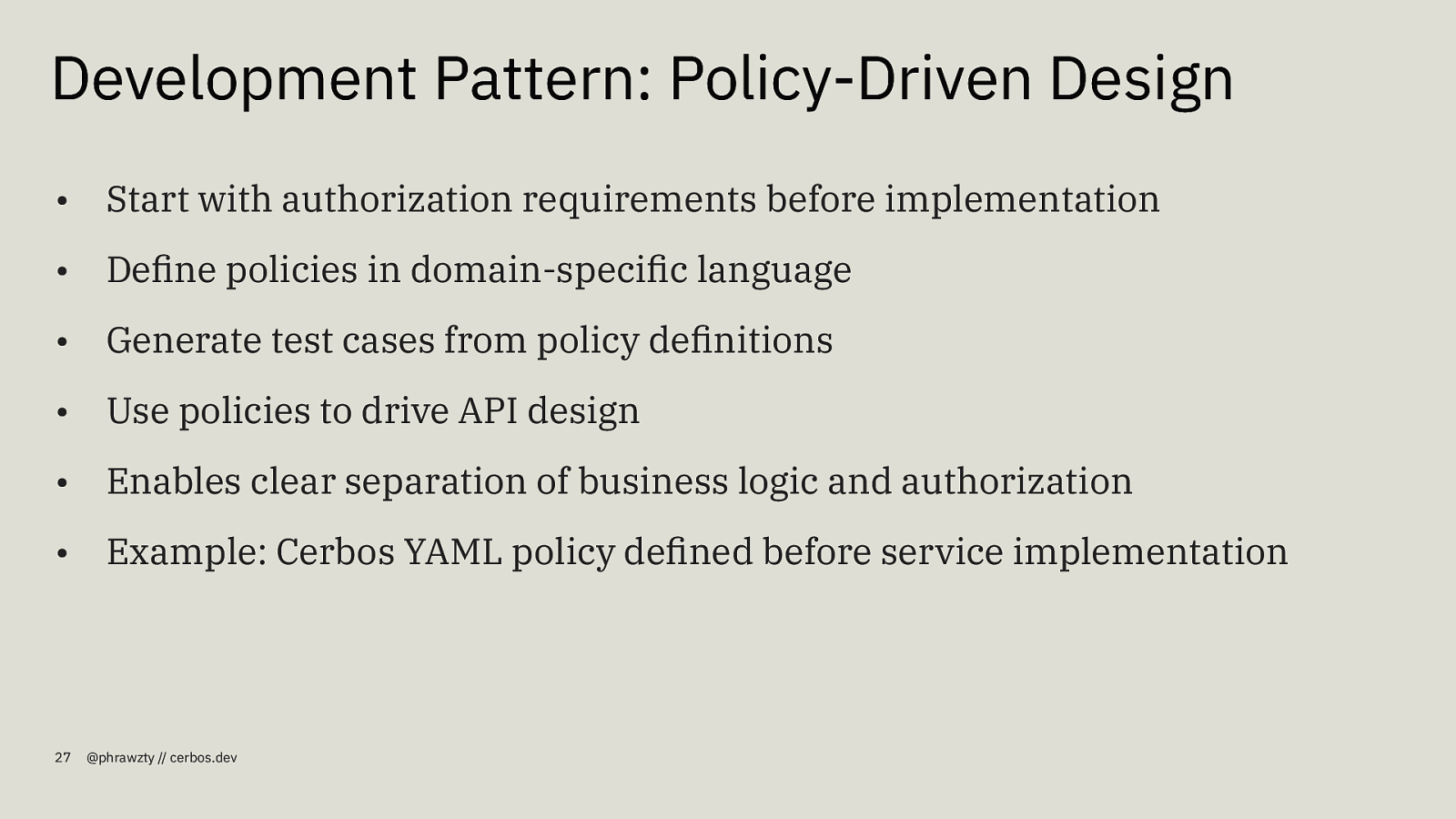
Development Pattern: Policy-Driven Design • Start with authorization requirements before implementation • Define policies in domain-specific language • Generate test cases from policy definitions • Use policies to drive API design • Enables clear separation of business logic and authorization • Example: Cerbos YAML policy defined before service implementation 27 @phrawzty // cerbos.dev
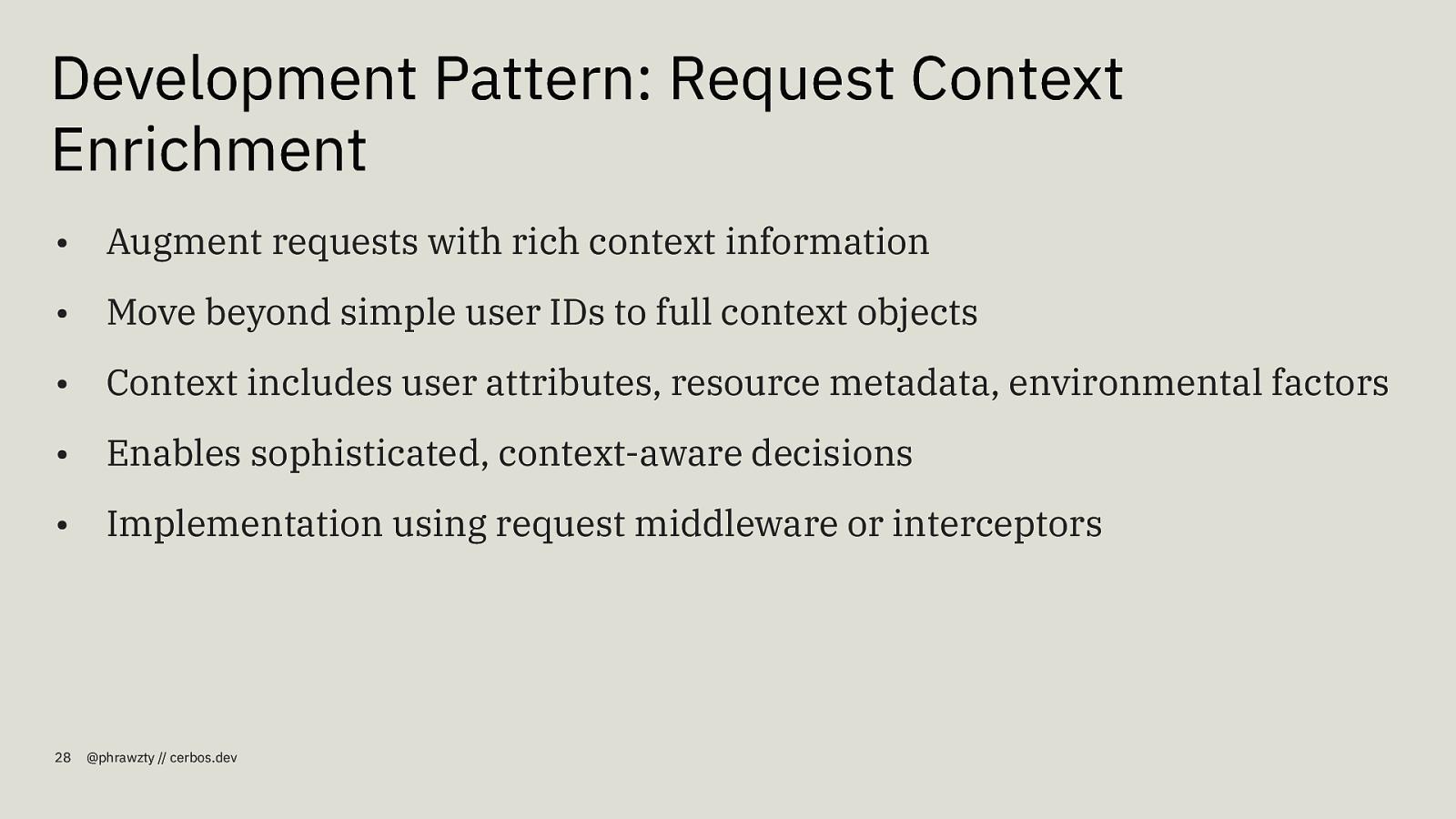
Development Pattern: Request Context Enrichment • Augment requests with rich context information • Move beyond simple user IDs to full context objects • Context includes user attributes, resource metadata, environmental factors • Enables sophisticated, context-aware decisions • Implementation using request middleware or interceptors 28 @phrawzty // cerbos.dev
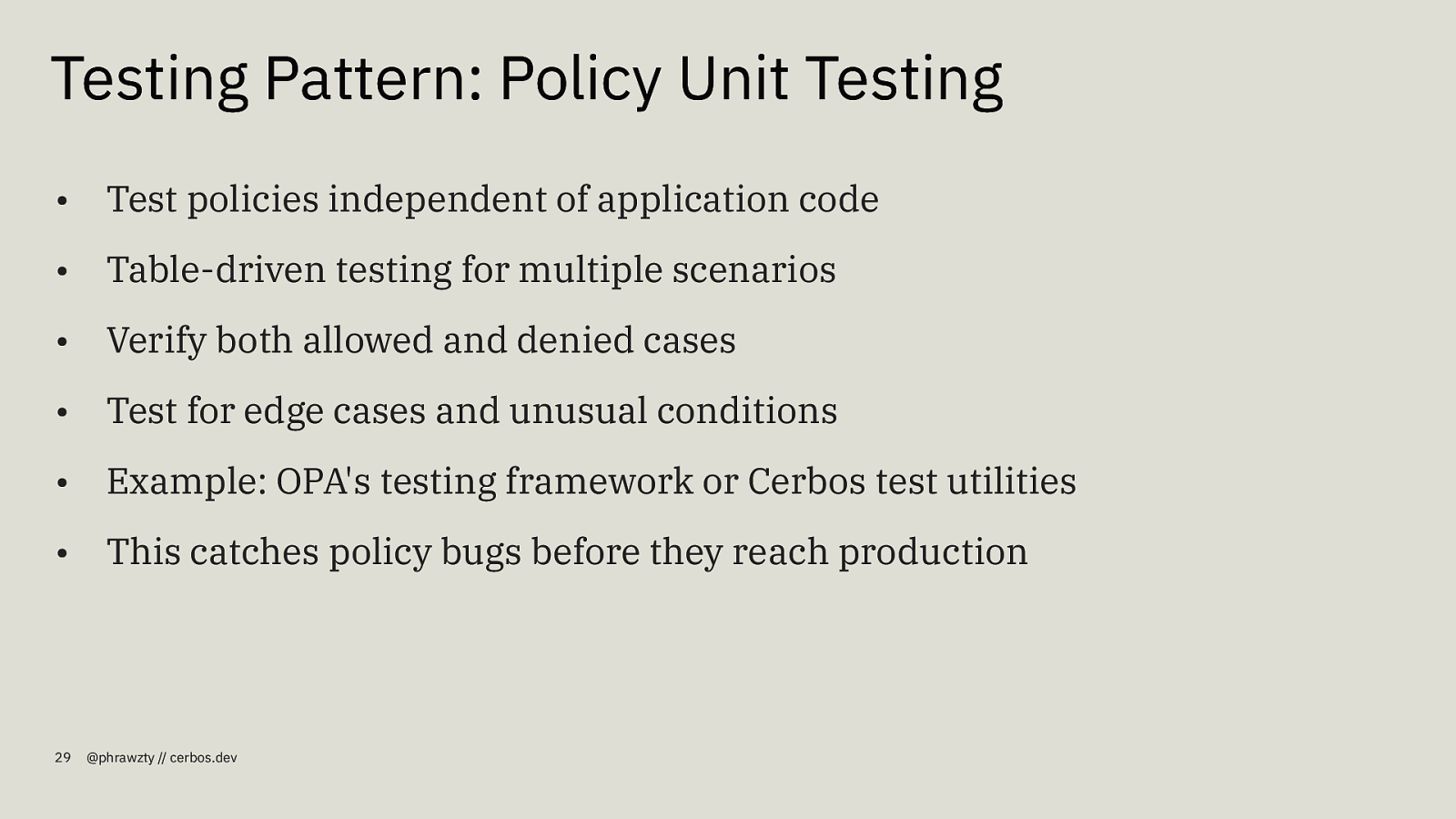
Testing Pattern: Policy Unit Testing • Test policies independent of application code • Table-driven testing for multiple scenarios • Verify both allowed and denied cases • Test for edge cases and unusual conditions • Example: OPA’s testing framework or Cerbos test utilities • This catches policy bugs before they reach production 29 @phrawzty // cerbos.dev
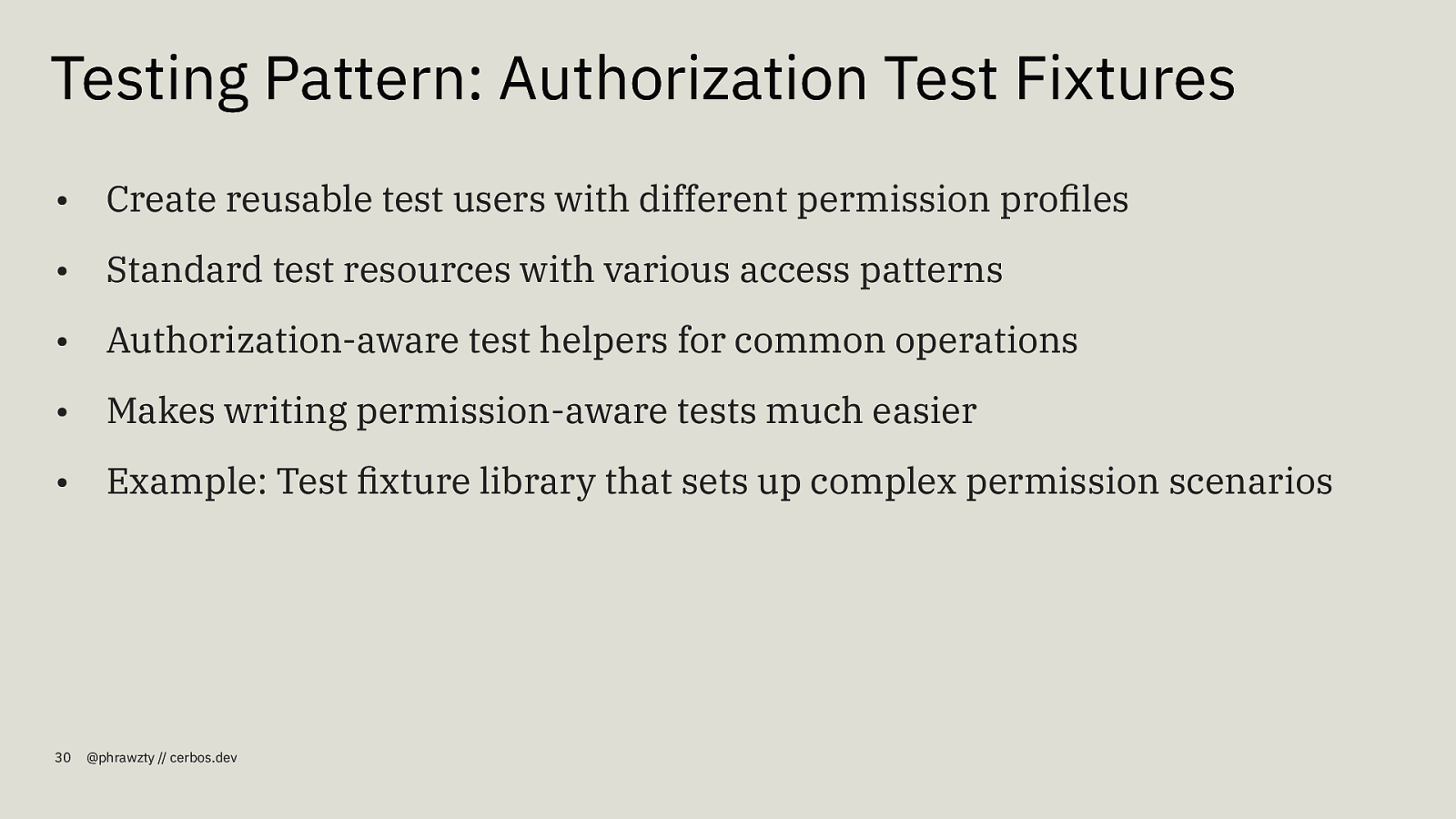
Testing Pattern: Authorization Test Fixtures • Create reusable test users with different permission profiles • Standard test resources with various access patterns • Authorization-aware test helpers for common operations • Makes writing permission-aware tests much easier • Example: Test fixture library that sets up complex permission scenarios 30 @phrawzty // cerbos.dev
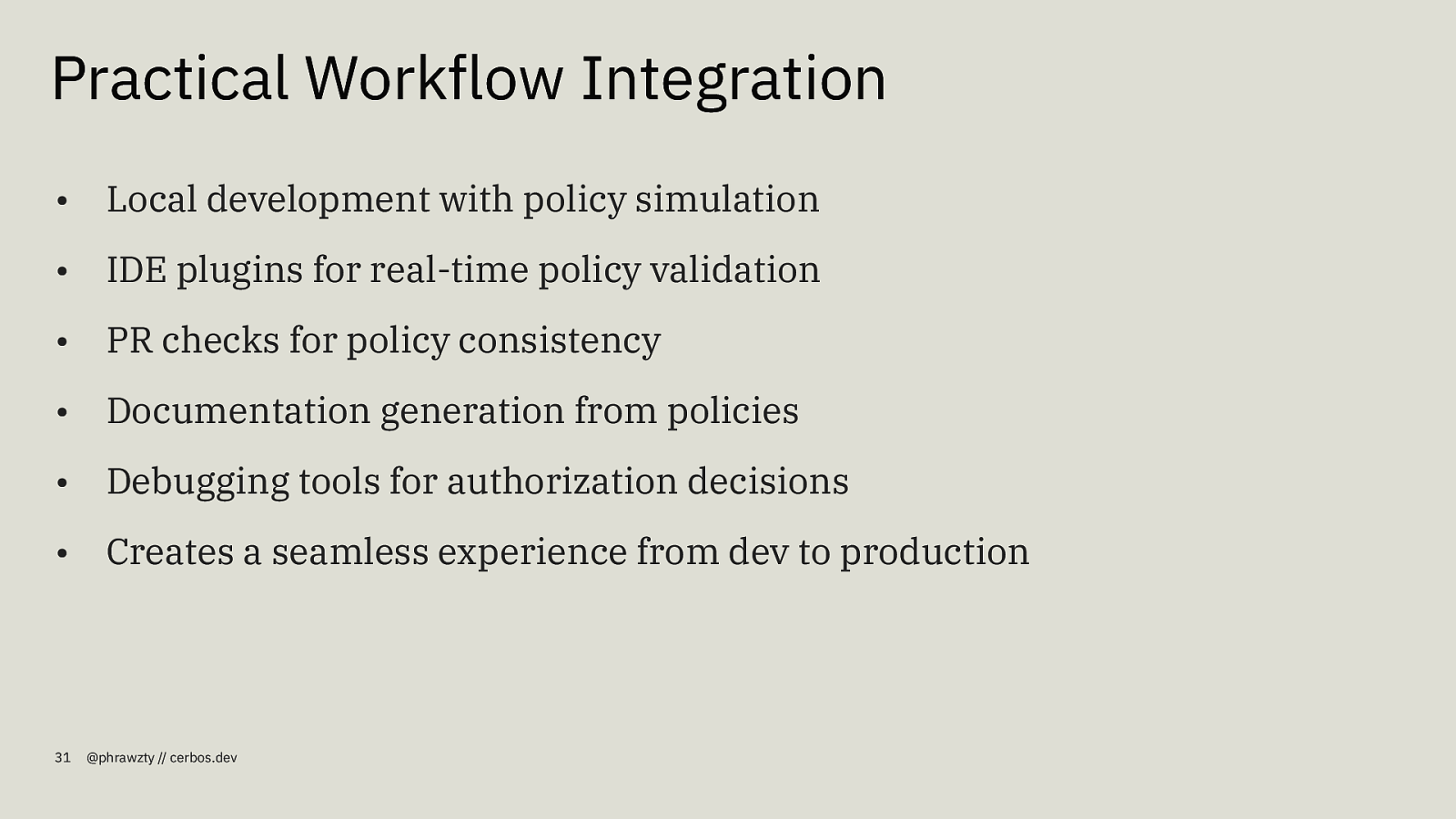
Practical Workflow Integration • Local development with policy simulation • IDE plugins for real-time policy validation • PR checks for policy consistency • Documentation generation from policies • Debugging tools for authorization decisions • Creates a seamless experience from dev to production 31 @phrawzty // cerbos.dev
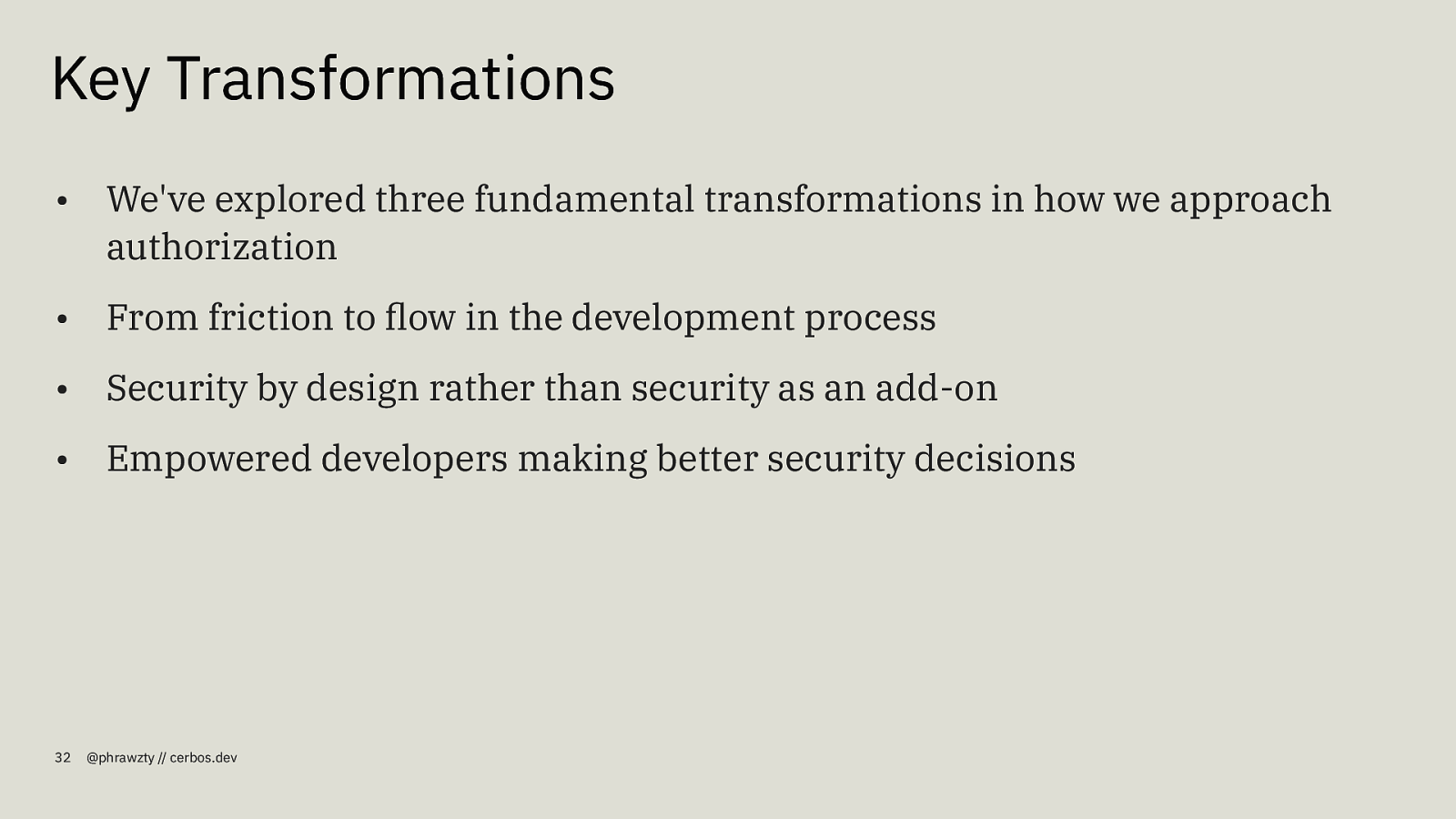
Key Transformations • We’ve explored three fundamental transformations in how we approach authorization • From friction to flow in the development process • Security by design rather than security as an add-on • Empowered developers making better security decisions 32 @phrawzty // cerbos.dev
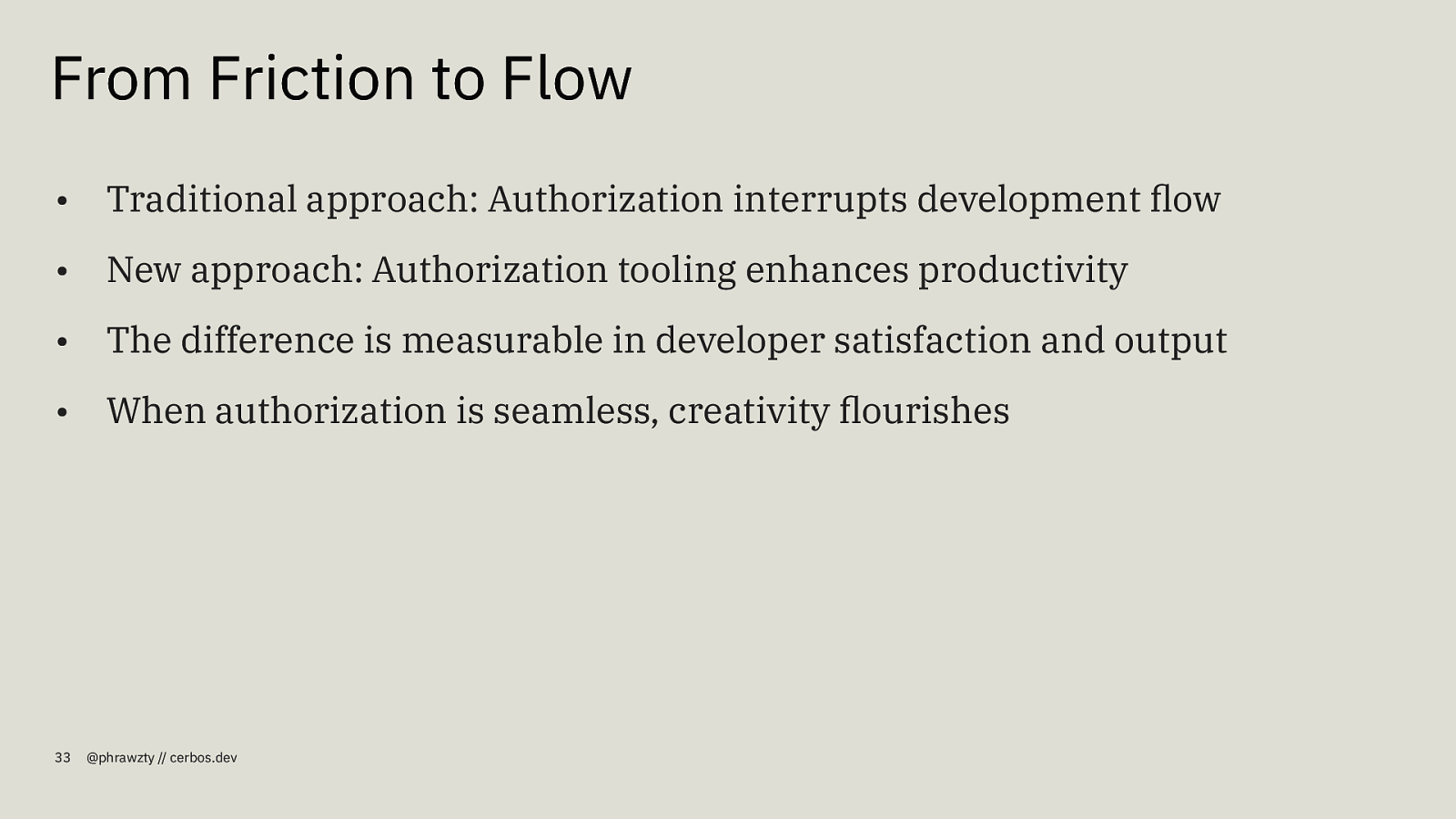
From Friction to Flow • Traditional approach: Authorization interrupts development flow • New approach: Authorization tooling enhances productivity • The difference is measurable in developer satisfaction and output • When authorization is seamless, creativity flourishes 33 @phrawzty // cerbos.dev
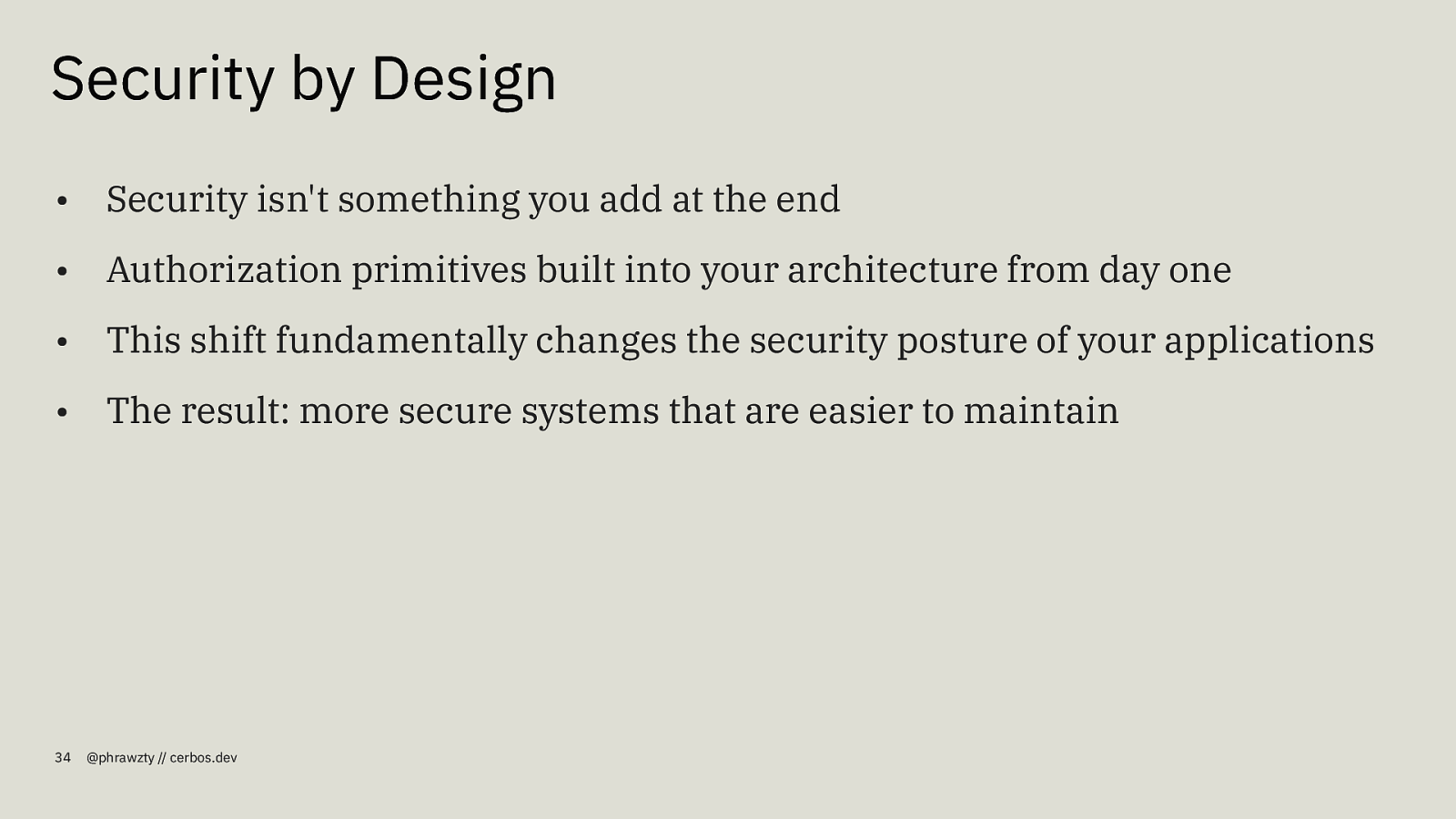
Security by Design • Security isn’t something you add at the end • Authorization primitives built into your architecture from day one • This shift fundamentally changes the security posture of your applications • The result: more secure systems that are easier to maintain 34 @phrawzty // cerbos.dev
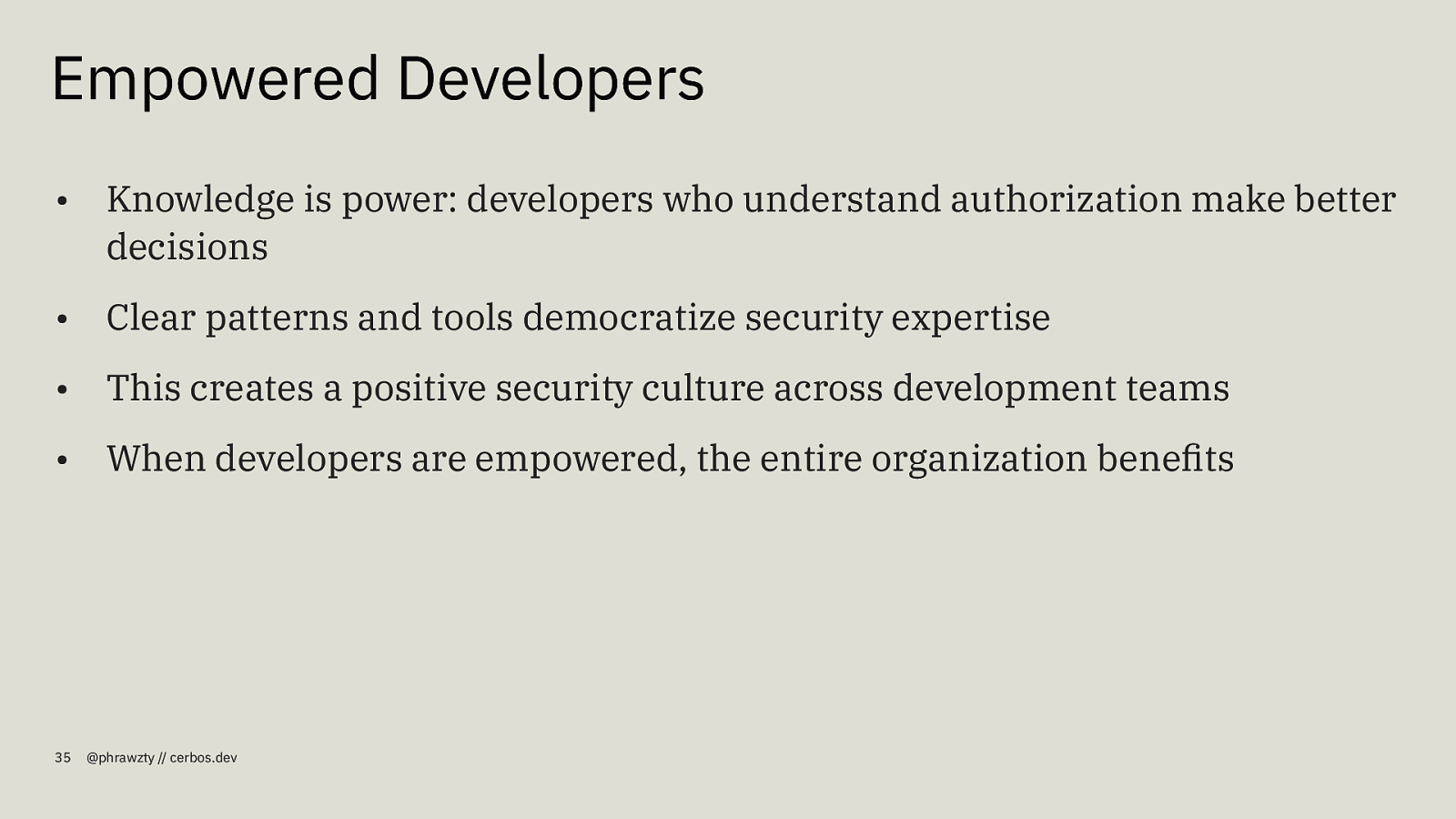
Empowered Developers • Knowledge is power: developers who understand authorization make better decisions • Clear patterns and tools democratize security expertise • This creates a positive security culture across development teams • When developers are empowered, the entire organization benefits 35 @phrawzty // cerbos.dev
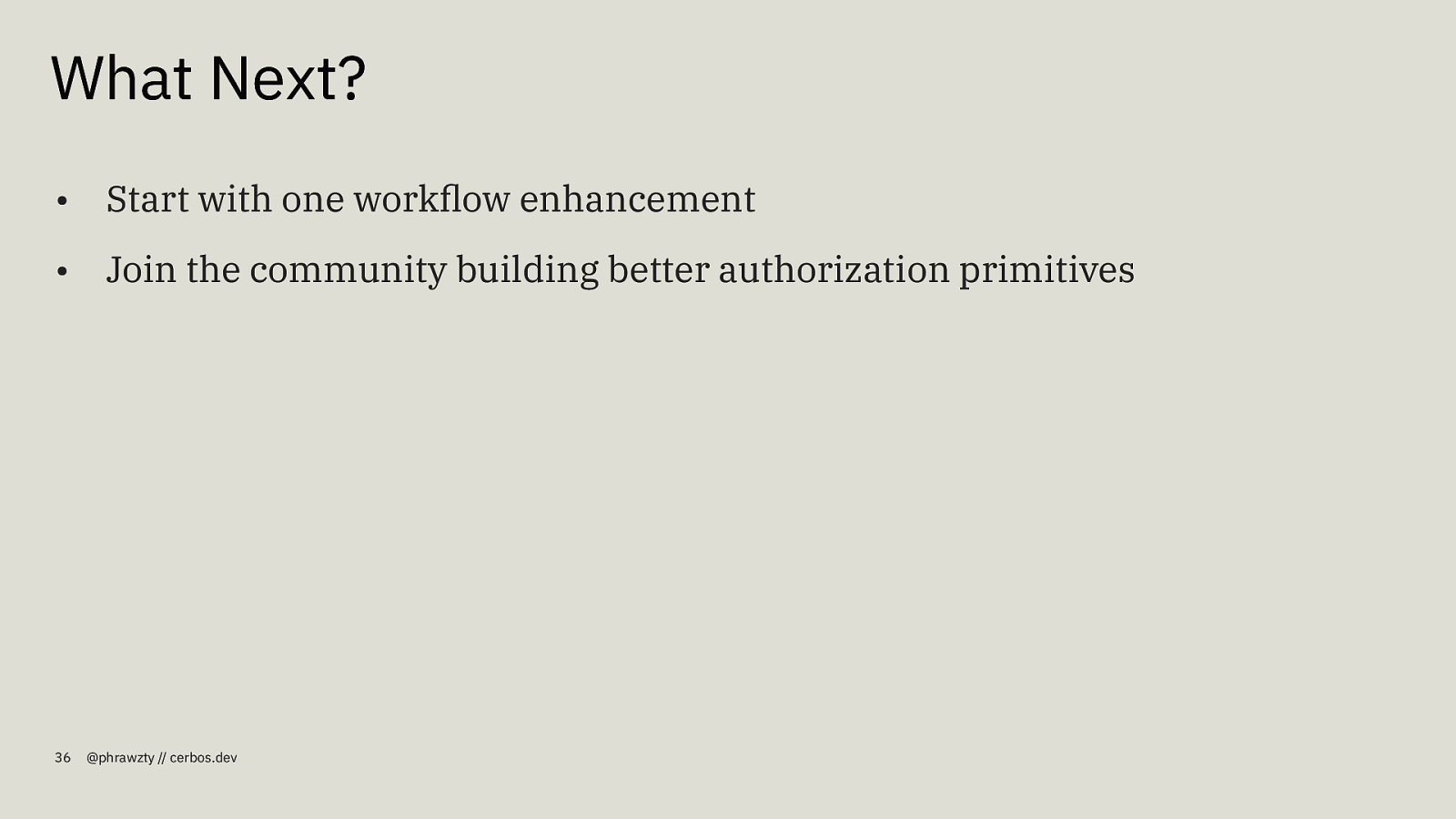
What Next? • Start with one workflow enhancement • Join the community building better authorization primitives 36 @phrawzty // cerbos.dev
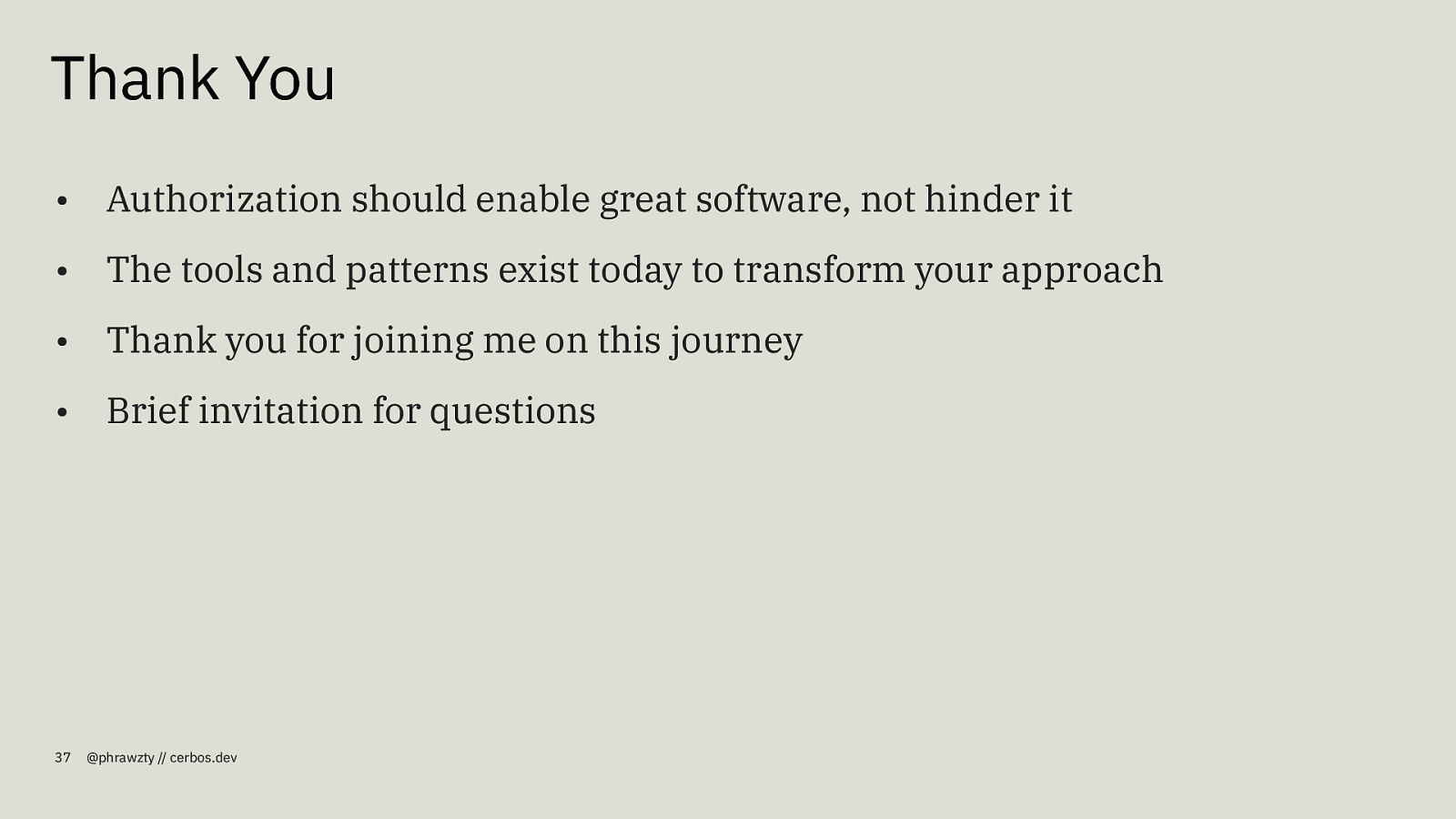
Thank You • Authorization should enable great software, not hinder it • The tools and patterns exist today to transform your approach • Thank you for joining me on this journey • Brief invitation for questions 37 @phrawzty // cerbos.dev
Every request in a cloud-native application needs authorization, but let’s be honest: most developers see it as a pain-point rather than an advantage. This talk explores why authorization belongs in your application’s critical path, and how making it a core part of the development process improves developer experience. We’ll look at how CNCF authorization projects and open standards from the OpenID Foundation are rethinking authorization from the ground up. Through real-world examples, we’ll show how modern authorization patterns fit into existing workflows, help catch access control bugs early, and make developers’ lives easier. Attendees will leave with practical patterns for building maintainable access control logic, strategies for testing authorization rules effectively, and proven approaches for embedding security into your development workflow from the start. Whether you’re building new systems or improving existing ones, you’ll learn how to make authorization work for you.
Video
Resources
The following resources were mentioned during the presentation or are useful additional information.
